#a cheap one just to learn techniques etc because like i don’t want to Make art™ i just want to Do something with my hands
Explore tagged Tumblr posts
Text
I want so badly to indulge in drawing again just so i can infect the masses with shitty little sketches of baby baby & baby
#shitty (deeply affectionate) btw#i got a drawing tablet in like december#a cheap one just to learn techniques etc because like i don’t want to Make art™ i just want to Do something with my hands#and i have instead been too busy to do any of that#but! there’s only like a month left of classes and the only really big thing is the essay i’m currently working on#so :))) soon :)))#even rn i’m taking a break i shouldn’t be taking lol#blogging with myself
1 note
·
View note
Text
I just wanted to talk about what I’ve learnt through my years of writing and learning about how to write characters n stuff
If there’s any young writers or people who want to make ocs or whatever out there i thought I’d share my mistakes and what I’ve learnt so that others can improve as I have.
Always research everything you write about, regardless on the topic. I’ve learnt that the best thing todo is really study when you’re writing a character, regardless of what the situation is.
when able, make sure you don’t just listen to one persons feedback on your writing or your characters, I got into a dangerous concept of characters and world building because my writing teacher thought it was a good idea when I later learned it wasn’t.
ALWAYS make sure you don’t tackle real world stuff and issues in your writing unless you really want to fully commit to studying that stuff and writing it in a way that does it justice. The last thing you want todo is have bias or misinformation in your writing. This ESPECIALLY applies to mental health.
4. make sure you’re careful about the dynamics and the way you write characters, make sure you don’t do something subtle that would lead the reader to think you’re endorsing problematic behaviour. I could use a bunch of examples but you’re probably familiar with this concept if you look at most media, for example.. the issue of making a serial killer or someone of that nature the ‘protagonist’ in a piece of media, be that writing or show or whatever, it doesn’t matter what the excuse is, if you make the main character a certain thing that would probably be problematic irl, it doesn’t matter the reasoning. People are made to assume the protagonist of the story is the hero or in some what supposed to be rooted for, you have to be very conscious of writing techniques and the effect tropes have on your audience before making a piece of media with this sort of thing.
5. know your audience, and know what you need todo to protect them. If your audience is young, make sure your writing doesn’t contain anything that could hurt them. Etc
6. When writing or coming up with a story it’s very important that you remember why people read books and stuff in the first place, it’s a form of escapism. What I’ve learnt is the best thing todo for a creative writing thing is to make it just distant enough from reality through fantasy or whatever to not trigger a panic or paranoia response in the readers subconscious, or whatever. Examples of this is sweettooth from Netflix, it’s got an otherwise cool story and concept, but because they made it so much like real life in aspects.. its not safe for someone like me or others to watch it as the story no longer feels like a story, it becomes too real and you really don’t want your story to distress or upset people.
7. Work with people who have whatever your character has or whatever race they are etc, work with a variety of people when producing a creative media that showcases a protagonist or characters like that. Of course studying on your own is good, but it’s important that the voices we want to write for are heard.
8. don’t go for cheap emotional shots, these days writers seem to think making stuff angsty or fluffy and wholesome or sexual are the only ways to make good writing that invokes an emotion, but that’s not true. There are so many untapped emotions and so many things you can do with your writing, don’t fall into the trap of ‘all I wanna do is make angsty content haha no character is safe from my torment’ or ‘I just want all my characters to be happy all the time’ or, ‘haha sex 24/7’ remember that good writing comes in all different shapes and you need to have a mixture of different elements in order to create good content, at least that’s how I see it in most good media.
9. find inspiration from books or stories that you like, for example. Undertale and deltarune is an inspiration for me.
and that’s it, I guess.. I’m not an expert of course I just wanted to share what I’ve learnt with anyone who could use the information, it’s been a slow progress trying to find out what works and what doesn’t with writing but I’m improving everyday.
#undertale#creative writing#writers on tumblr#writeblr#writing community#good advice#advice#just my take#writing tips#writing advice#hope this helps#If this isn’t good you can tell me I’m open to criticism dont be shy
5 notes
·
View notes
Note
I noticed that you've done Chinese calligraphy (very pretty btw) and I wanted to ask if you know of any good resources for beginners?
heya!!!! thanks for that!! this is a timely ask because i was thinking i’d do a round-up anyway some time down the road so this is good XD
firstly tho, i’d like to put out a disclaimer that i’m no expert at this and am pretty much an amateur. so i took calligraphy classes for three years at a national calligraphy center (not that it made me a pro or shite because i don’t one bit have a natural affinity for it). if there are any calligraphy experts on this site, please feel free to add to this or correct me.
once again, i’m not claiming that everything i know is super accurate, all my basics were taught by a teacher so i’m not super sure where to go for self-learning but here’s what i know in brief for an unreliable, personal crash course:

↳ there are a lot of types of calligraphy, but i’ll just simply go on two types for now:
(1) normal calligraphy 书法 with a 毛笔 (calligraphy brush)

(2) contemporary calligraphy 硬笔书法 that’s done with a pen (can be 0.7/1.0 ball point or fountain pens with thin/thick nibs etc., although using fountain pens is considered something influenced by the west, and a lot of people prefer to use inky ball points instead for better flexibility)

↳ in terms of font/style there are five main groups (of which examples i will give in calligraphy brush, not a normal pen), and the first two are the most commonly used ones:
(1) 行书 - semi-cursive script


(2) 楷书 - regular script


(3) 草书 - cursive script

(4) 篆书 - seal script

(5) 隶书 - clerical script

↳ what are the differences and how do you pick a style to begin with?
in general people start with either 行书 or 楷书 especially for young adults these days because honestly, these are the more clearly visible forms that most of us that read chinese can decipher, as you can probably tell from the above differences. it’s literally chinese as most of us know it.
even those who’ve practiced calligraphy for a really long time are still kind of arguing on whether beginners should start with 行书 or 楷书, and the 楷书 camp advocates for the learning of regular script before they start inventing with semi-cursive 行书, which has its own merits. after all, with 楷书 you do learn the basics of how to start a stroke, end a stroke, the structure of characters split for the best composition (that’s why a lot of people practice on grid paper), but there are those who started with 行书 that say it’s easier to go to 楷书 after you learn semi-cursive.
the rule of thumb is, learn the style you like best and you think you can follow best. i began with 楷书 and honestly haven’t figure out 行书 much i have to say. although personally, if you are not familiar with chinese characters in general, i’d recommend going with 楷书 first. only because you know exactly how many strokes there are etc., whereas with semi-cursive there are some tricks to it that you might not need to know right now.
篆书 is considered like an ancient form of writing font and was used in certain periods and dynasties not that i know which ones, but if you watch certain cdramas, you’ll definitely have seen this font - this font is also commonly used to make stamping seals (i’ll explain what’s written on seals below)

隶书 was invented sometime after that for, as the name suggests, administrative purposes where clerics required a faster font to write with. lastly, there’s 草书, which as you can tell, is a hell lot harder to decipher! this is because this font was created more as an aesthetic, art form than actual like reading. there are some that are of course written clearly, but the extreme curves and like sometimes even thicker brushes are used for aesthetics/style sake like this one:
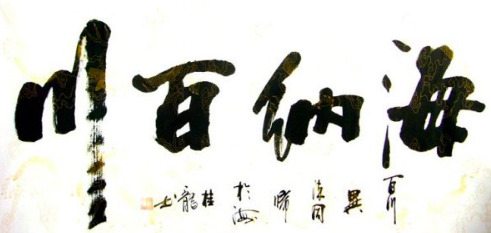
↳ some general advice when you’re practicing
(1) this is a time-intensive practice and requires a lot of patience but is incredibly rewarding - it’s not something that will come immediately even if you watch tutorials and practice a single word for like a week. just like english calligraphy, you’ll probably have to practice for months/years depending on how much you can practice BUT it’s not as if you need to put up ‘perfect’ work each time, and it’s more important to find your own style after getting the basics right
(2) my teacher and a lot of calligraphy enthusiasts always nag and say: chinese calligraphy is not about just technique, you need to write with the heart - [练字重在热情, 只要能���持就好] this sound incredibly philosophical but is pretty much the old adage of if you like something and have passion for it, keep at it and you’ll get it eventually

↳ brushes
okay, here’s where it might get a little complicated - the type of brush you need depends on the type of font you’re going for, and of course if you don’t have that many choices, just go for whatever you have as long as the ends of the brush aren’t split [cr: https://www.sohu.com/a/343812958_161249]
(1) 硬毫笔 (hard): made of wolf, horse, rabbit, deer hair etc.
(2) 软毫笔 (soft): made of sheep hair etc.
(3) 兼毫笔 (medium): mixed with hair used to make both hard and soft brushes
(4) i think there are now brushes made of synthetic hair as well now #technology especially if it’s a cheap brush, also there are only so many animal hairs you can grab XD
obviously, is it more difficult to start with (2), the soft brush - it is said that once you begin with the soft brush and master it, you can use any brush. i started with a hard brush, especially for 楷书 because you need a hard brush to help you end the strokes precisely but that’s because i’m half a noob
for 行书 and 草书, because it’s cursive right and requires flexibility, of course a soft brush works better!
length of the brush matters as well - it is easier to control a shorter and slightly thicker brush than it is to control a lengthier and thinner brush - i’ve tried both, and i died with the second one, you can see the different varieties here:

*most calligraphy brushes for daily normal practice have pointed tips, the one you see on the far left is obviously a wide tip and this is only used for larger or huge pieces, those with four characters, and typically used with 草书
size of your desired font matters too - if you’re going for a dainty size, do use smaller, shorter and thinner brushes like these:

regular sized fonts would do well with brushes like these:
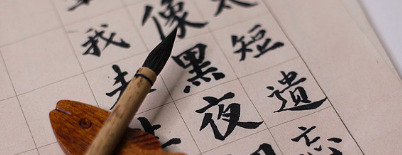
↳ paper
(1) print
square paper is your best friend - beginners should honestly start with grid paper and the type that sections the square nicely for you here, but once you’re familiar, any square/grid paper will do for practice, any size works as well, depends on what size font you’re trying to go for
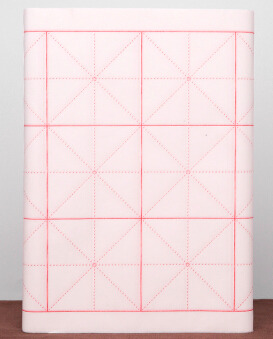
square/columned/blank paper for final product
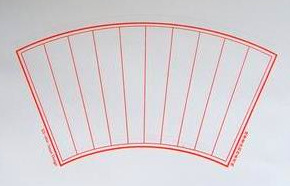
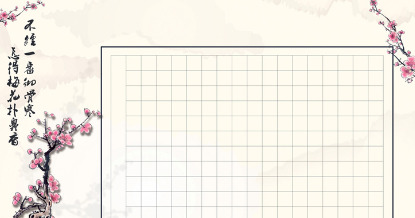

(2) paper types
yellow or white thin calligraphy practice paper, made of rice or normal paper - usually comes in a huge stack, feels a little like felted paper - they’re also usually folded into huge scroll-like stacks
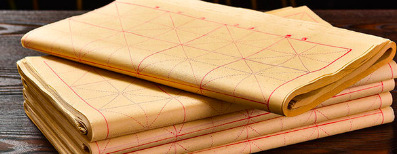
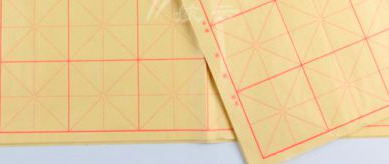
normal A4 grid or column foolscap/paper - this list is not exhaustive, you can technically use any type of paper as long as it helps you to space out the words nicely
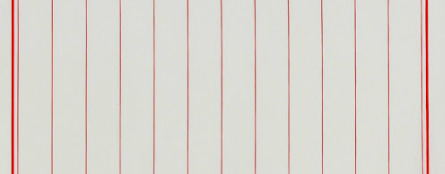
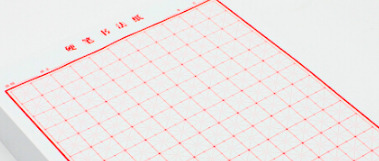
↳ miscellaneous accessories
(1) ink and ink holder - there is a special kind of ink for calligraphy called 墨 and people usually just buy it in bottles these days. in ancient times you had to 研墨 rub/scrape the ink out (which you can see with the rectangular pieces below). it honestly has a really pungent smell in my opinion for certain brands especially the cheaper ones, but that’s the authentic type i guess!
as for ink holders, just use a tiny plate or a tiny sauce plate (i stole one from my grandma XD)

(2) brush holder - not really necessary unless you have a lot of brushes and need a place to hold them. the reason to have one of these is also because it’ll help the brush keep its shape and will help it last longer as well
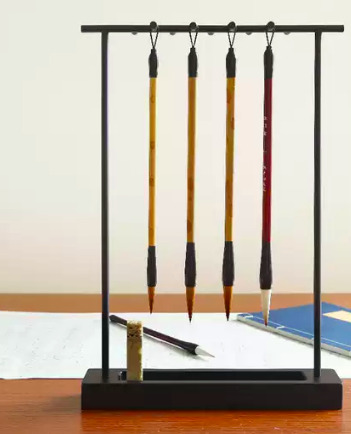
(3) stamps - for a final product, you should end it with a stamp! there are different types of stamps and different types of fonts, you can use the seal font for this as well, or just usual regular script this is your watermark/signature for calligraphy pieces
shapes come in ovals, squares, circles
characters in the stamp - it can be your surname, your full name, or even like a full poem for a huge stamp
ink - usually when you purchase a stamp and have it carved, it comes also with a red ink stamp pad, traditionally, stamps on calligraphy pieces are stamped in red

(4) felt base - we use felt bases so that when you write the ink doesn’t seep through the paper! but honestly newspaper works as well, but i bought it for real cheap on taobao
(5) paper weights - buy some nice chinese-style paperweight or just use whatever you have on hand because the papers are REALLY THIN and always end up flying somewhere

(1) get your strokes right first
honestly, get all your single/compound strokes right first! which means starting with words such as 一,二,三 and others
some videos:
youtube
youtube
(2) move onto other more complex words, one at a time
youtube
(3) print practice papers, get tracing paper and trace over each
here’s one but any works: https://kuaibao.qq.com/s/20191230AZP1AK00?refer=spider
---
so that’s all i have!! let me know if you’ve got any other questions or need some other resources for me to point you to!
#calligraphy#chinese calligraphy#chinese#calligraphy 101#毛笔#书法#also i'm trying to put the read more button i cannot#i literally can't edit this
382 notes
·
View notes
Text
How the Sacklers rigged the game
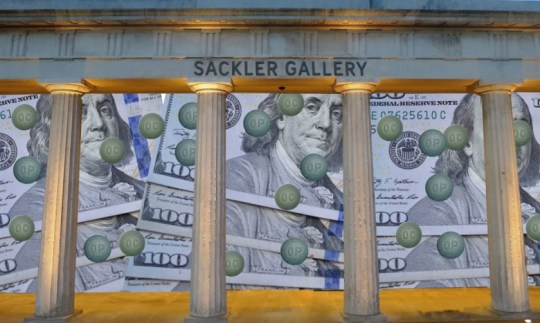
Two quotes to ponder as you read “Purdue’s Poison Pill,” Adam Levitin’s forthcoming Texas Law Review paper:
“Some will rob you with a six-gun, And some with a fountain pen.” (W. Guthrie)
“Behind every great fortune there is a great crime.” (H. Balzac) (paraphrase)
Some background. Purdue was/is the pharmaceutical company that deliberately kickstarted the opioid crisis by deceptive, aggressive marketing of its drug Oxycontin, amassing a fortune so vast that it made its owners, the Sackler family, richer than the Rockefellers.
Many companies are implicated in the opioid crisis, but Purdue played a larger and more singular role in an epidemic that has killed more Americans than the Vietnam war: Purdue, alone among the pharma companies, is almost exclusively devoted to selling opioids.
And Purdue is also uniquely associated with a single family, the Sacklers, whose family dynasty betrays a multigenerational genius for innovating in crime and sleaze.
The founder of the family fortune, Arthur Sackler, invented modern drug marketing with his campaigns for benzos like Valium, kickstarting an addiction crisis that burned for decades and is still with us today.
His kids, while not inventing the art of reputation laundering through elite philanthropy, did more to advance this practice than anyone since the robber barons whose names grace institutions like Carnegie-Mellon University.
The Sackler name became synonymous not with the cynical creation of a mass death drug epidemic and a media strategy that blamed the victims as “criminal addicts” — rather, “Sackler” was associated with museums from the Met to the Louvre.
Handing out crumbs from their vast trove of blood-money was just one half of the Sacklers’ reputation-laundering. The other half used a phalanx of vicious attack-lawyers who’d threaten anyone who criticized them in public (I personally got one of these).
The Sacklers could not have attained their high body count nor their vast bank-balances without the help of elite legal enablers, both the specialists from discreet boutique firms and the rank-and-file of the great white-shoe firms.
I’m not one to take cheap shots at lawyers. Lawyers are often superheroes, defending the powerless against the powerful. But the law has a bullying problem, a sadistic cadre of brilliant people who live to crush their opponents.
https://pluralistic.net/2021/02/10/duke-sucks/#devils
To see the sadism at work, look no further than the K-shaped world of bankruptcy: for the wealthy, bankruptcy is the sport of kings, a way to skip out on consequences. For the poor, bankruptcy is an anchor — or a noose.
When working people are saddled with debts — even debts they did not themselves amass — they are hounded by petty, vindictive monsters who deluge them with calls and emails and threats.
https://pluralistic.net/2021/05/19/zombie-debt/#damnation
But it’s very different for the wealthy. Community Hospital Systems is one of the largest hospital chains in America, thanks to the $7.6b worth of debt it acquired along with 80+ hospitals, which it is running into the ground.
https://pluralistic.net/2021/05/18/unhealthy-balance-sheet/#health-usury
CHS raked in hundreds of millions in interest-free forgivable loans, stimulus and other public subsidies and paid out millions from that to its execs for “performance bonuses.”
It also leads the industry in suing its indigent patients, some for as little as $201.
Debt and bankruptcy are key to private equity’s playbook, especially the most destructive forms of financial engineering, like “club deal” leveraged buyouts that turn productive businesses into bankrupt husks while the PE firms pocket billions:
https://pluralistic.net/2021/05/14/billionaire-class-solidarity/#club-deals
For mere mortals — those of us who can’t afford to hire legal enablers to work the system — bankruptcy is a mystery. If you know someone who went bankrupt, chances are they had their lives destroyed. How can bankruptcy be a gift, rather than a curse?
Purdue Pharma presents a maddening case-study in the corrupt benefits of bankruptcy. When it was announced in March, many were outraged to learn that the Sacklers were going to walk away with billions, while their victims got stiffed.
https://pluralistic.net/2021/03/31/vaccine-for-the-global-south/#claims-extinguished
Levitin’s paper uses the Purdue bankruptcy as a jumping-off point to explain how this can be — how corporate bankruptcy “megacases” have become a sham that subverts the very purpose of bankruptcy: to allow orderly payments to creditors while preserving good businesses.
Levitin identifies three pathologies corrupting the US bankruptcy system.
First is “coercive restructuring techniques” that allow debtors and senior creditors to tie bankruptcy judges’ hands and those of other creditors, overriding bankruptcy law itself.
These techniques — “DIP financing agreements,” “Stalking Horse bidder protections,” “Hurry-up agreements,” etc — are esoteric, though Levitin does a good job of explaining each.
More significant than their underlying rules is their effect.
That effect? Thousands of Oxy survivors and families of Oxycontin victims lost their right to sue the Sacklers and Purdue pharma because of these techniques. In return, the Sacklers surrendered about a third of the billions they reaped.
https://www.reuters.com/article/us-purduepharma-bankruptcy/sacklers-reaped-up-to-13-billion-from-oxycontin-maker-u-s-states-say-idUSKBN1WJ19V
Depriving the victims of the Sacklers’ drug empire of the right to sue doesn’t just leave the Sacklers with billions; it also means that no official record will be produced detailing the Sacklers’ complicity in hundreds of thousands of deaths.
Levitin: “The single most important question in the most socially important chapter 11 case in history will be determined through a process that does not comport with basic notions of due process.”
The Sacklers are not unique beneficiaries of “coercive restructuring techniques.” The rise of “prepack” and 24-hour “drive through” bankruptcies have turned judges into rubberstampers of private agreements between debtors and their cronies, with no look-in for victims.
It in these proceedings that the law descends into self-parody, more Marx Brothers than casebook. Levitin highlights the Feb ’21 “drive-through” bankruptcy of Belk Department Stores, where the judge was told that failing to accede to the private deal would risk 17,000 jobs.
The trustees representing Belk’s non-crony creditors were railroaded through this “agreement,” upon notice consisting of an “unintelligible” one-page, one-paragraph release opening with “a 630-word sentence with 92commas and five parentheticals.”
Sackler lawyers were geniuses at this game, securing judicial approval of a deal where the Sacklers’ personal liability to the Feds went from $4.5b to $225m. The judge heard no evidence about whether the Sacklers’ voluntary payout was even close to their liabilities.
The corruption of bankruptcy is bad enough, as the creditors for finance criminals are often small firms and workers’ pension.
The Sacklers’ case is far worse: they don’t owe billions in unpaid loans — they owe criminal and civil liability for the lives they destroyed.
The next area of corruption that Levitin takes up is the inadequacy of the appeals process for bankruptcy settlements. This, too, is complex, but it has a simple outcome: once a judge agrees to a settlement, it’s virtually impossible to appeal it.
In those rare instances where people do win appeals, they are still denied justice, because the appellate courts typically find that it’s too late to remedy the lower courts’ decisions.
That makes the business of “coercive restructuring techniques” (in which judges rubber-stamp corrupt arrangements between debtors and their cronies) even more important, since any ruling from a bankruptcy judge is apt to be final.
The third and most important corrupt element of elite bankruptcy that Levitin describes is the ability for debtors’ lawyers to pick which judge will rule on their case, a phenomena that means that only three judges hear nearly every major bankruptcy case in America.
“[In 2020] 39% of large public company bankruptcy filings ended up before Judge David Jones in Houston. 57% of the large company cases ended up before either Jones or two other judges, Marvin Isgur in Houston and Robert Drain in White Plains.”
https://www.creditslips.org/creditslips/2021/05/judge-shopping-in-bankruptcy.html
In other words, elite law firms have figured out how to “hack” the bankruptcy process so they can choose from among three judges. And these three judges weren’t picked at random — rather, they competed to bring these “megacases” to their courts.
This competition is visible in how these judges rule — in ways that are favorable to cronyistic arrangements between debtors and their favored, deep-pocketed creditors — and in the public statements the judges themselves have made, going on the record admitting it.
Levitin cites the groundbreaking work of Harvard/UCLA law prof Lynn LoPucki on why judges want to dominate bankruptcy megacases. LoPucki points out hearing these cases definitely increases “post-judicial employment opportunities” — but says the true motives are more complex.
Levitin, summarizing LoPucki: “[it’s more] in the nature of personal aggrandizement and celebrity and ability to indirectly channel to the local bankruptcy bar.. The judge is the star and the ringmaster of a megacase — very appealing to certain personalities”
Obviously, not every judge wants these things, but the ones that do are of a type — “willing and eager to cater to debtors to attract business…[an] assurance to debtors that…these judges will not transfer out cases with improper venue or rule against the debtor��”
Forum-shopping in bankruptcy is not new, but it has accelerated and mutated.
Once, the game was to transfer cases to Delaware and the Southern District of New York.
It’s why the LA Dodgers went bankrupt in Delaware, why Detroit’s iconic General Motors and Texas’s own Enron got their cases heard in the SDNY.
The bankruptcy courts have long been in on this game, allowing the flimsiest of pretences to locate a case in a favorable venue.
For example, GM argued that it was a New York company on the basis that it owned a single Chevy dealership in Harlem.
Other companies simple open an office in a preferred jurisdiction for a few months before filing for bankruptcy there.
Lately, the venue of choice for dirty bankruptcies is in Texas (if only Enron could have held on for a couple more decades!). Only two Houston judges hear bankruptcy cases, and any bankruptcy lawyer who gets on their bad side risks ending their career.
Once a court becomes a national center for complex bankruptcies, the bankruptcy bar works to ensure that only favorable judges hear cases there, punishing a district by seeking other venues when a judge goes “rogue.” The fix is in from the start.
Purdue did not want to have its case heard in Texas. Instead, it manipulated the system so that it could argue in front of SDNY Judge Robert D Drain.
It was a good call, as Drain is notoriously generous with granting “third-party releases,” which would allow the Sacklers to escape their debts to the victims and survivors of their Oxy-pushing.
Once Drain agreed to the restructuring, he ensured that the victims would never get their day in court, and no evidence — from medical examiners, auditors, and medical professionals who received kickbacks for every patient they addicted — would be entered into the record.
Drain is also notoriously hostile to independent examiners, “an independent third-party appointed by the court to investigate ‘fraud, dishonesty, incompetence, misconduct, mismanagement, or irregularity…by current or former management of the debtor.”
But getting the case in front of Drain took some heroic maneuvering by the Sacklers’ lawyers. Levitin tracks each step of a Byzantine plan that somehow allowed a company that gave its address in Connecticut to have its case heard in New York.
The key to getting in front of Judge Drain appears to involve literally hacking the system, by putting a Westchester County location in the machine-readable metadata for its filing in the federal Case Management/Electronic Case Files (CM/ECF) system.
CM/ECF does not parse the text of the PDF that it receives from lawyers; only the metadata is parsed. The company listed a White Plains, NY address in this metadata, even though it had never conducted business there.
Purdue seems to have opened this office 192 days earlier for the sole purpose of getting its bankruptcy in front of Judge Drain (they were eligible for Westchester County jurisdiction 180 days after opening the office).
Their lawyers even went so far as to pre-caption the case filing with “RDD” — for “Robert D Drain” — knowing that all complex bankruptcies in Westchester County were Drain’s to hear.
The fact that the Sacklers were able to choose their judge — a judge who was notorious for his policies that abetted elite impunity in bankruptcy — is nakedly corrupt.
This move is how the Sacklers are walking away from corporate mass murder with a giant fortune. The art galleries have started to remove their names from their buildings, but they’ll have a lot of money to keep themselves warm even if they’re shunned in polite society.
A couple weeks ago, a Texas judge ruled against the NRA, denying its bankruptcy, on the grounds that it was a flimsy pretence designed to escape liability in New York, where it was incorporated.
https://apnews.com/article/nra-bankruptcy-dismissed-a281b888b64d391374f24539a820d60f
For many of us, the NRA bankruptcy was a kind of puzzle. We went from glad that the NRA was bankrupt to glad that they WEREN’T, because for dark money orgs like the NRA, bankruptcy isn’t a punishment, it’s a way to escape justice.
The NRA case is evidence that the corruption of the bankruptcy system isn’t yet complete. That’s no reason to assume everything is fine. The Sacklers are developing a playbook that will be used to escape other elite crimes with vast fortunes intact.
Image: Geographer (modified) https://commons.wikimedia.org/wiki/File:Serpentine_Sackler_Gallery.jpg
CC BY-SA https://creativecommons.org/licenses/by-sa/4.0/deed.en
38 notes
·
View notes
Note
I don’t want this to come across as, like, pity because it’s not and I’m sure you don’t want that, I mean this in the normalest, friendliest, least parasocial way possible because having followed you for years and spoke to you a few times it sucks that you are in this situation and have had to repeatedly go through it: can we help you somehow? Ko fi donations, Amazon wishlist, therapy fund etc? Is there anything we could do to make things a little more bearable?
For one I just wanna say that it actually just in itself means a lot that people are wanting to help me or at least vocally reaching out because like.. this is such a big world we're living in and its so easy to feel like i dont mean shit or matter for shit or can change shit at all so its nice to know that like. I dunno.. im glad i was able to kinda find this space for myself because like i dont really have a social life and without you guys (using "you guys" as a general word for all of my online friends rn) i wouldn't have anyone else to turn to
And also I don't perceive you guys wanting to help me as pity at all and really its kind of just validation because I'm basically 24/7 doubting myself and "am I valid for x, am I valid for y" so when im having kind of a crisis and people actually say "shit bro you ok" that feels better than like. I dunno. What does mother usually say. Stuff that's meant to be supportive but is kind of just toxic positivity like "You're overreacting and don't even think about it" which, those can be valid grounding techniques but like, you usually try and soothe the initial feeling first and then tell yourself not to think about it if you're obsessing over it
So I typed up what accidentally turned into a huge paragraph but, as nice as an Amazon wishlist sounds --because it makes me feel good people like me and gifts are always nice of course-- I would feel guilty for even making that public, and, to be realistic, my rent is very cheap and the only reason I don't have a lot of savings is because I keep spending money on bullshit. I kind of need to exercise restraint and actually save money because uh like I've been working for like 2 or 3 years now and I basically still have what I started with. So. I guess TLDR is "i would feel guilty accepting gifts i can technically afford for myself and also I would feel like a total chump beggar ��". Maybe when I learn more self kindness I'll feel less guilt accepting gifts I guess? Where i am right now, it just feels like I'm being, I dunno, manipulative
Monetary donations are kind of the same and I'm stricter on that and try not to take money unless there's some kind of emergency. I do worry about money a lot but its usually always in the "how can I support myself on my own in the future" sense. I mean, most people put away a small part of every paycheck, but my savings account actually kind of expired and got closed so I just have the one checking one and uh, it's easy for me to keep pulling out of it, you know 💀 but that circles back to "i have to personally learn how to exercise financial restraint" and also like. Let's not. Think about how all the socioeconomic policies in America aren't even remotely in my control so I should uh try and ignore that technically no job is paying enough and everyone has to have roommates or a spouse to afford anything 😅
And also. Yeah I'm ok on like therapy funds and stuff because I'm actually on state insurance, actually I'm trying to cut down my work hours to guarantee I stay in the right financial bracket so I can keep it. I was talking to a couple people last night and I might consider going to a doctor again soon but im really hesitant about it. It kinda seems like I need a more thorough evaluation from a psychiatrist and. Well.
I think my first "big goal" for right now is that I should put some money aside and. Uh. Well. Kinda quit my job for a while so I can focus on those sorts of things. I feel really bad even saying that but the fact is, the fact is, im a person with severe mental illness and depression and my current job involves random strangers constantly constantly treating me like shit and sometimes getting very verbally abusive and aggressive and sometimes just having someone suddenly approach me can be very startling? Did I ever tell you guys about the time a random older man just came up from behind me and briefly grabbed me from behind? It was ad a joke and I was on edge watching my peripheral vision for motion that entire week
So I guess to make a long story short I think I should. Focus on what I want to do in terms of medicine right now and really fight to pursue the fact I think some really important diagnoses have been missed, and to do that without a lot of stress, to have a flexible schedule to see a doctor, I think the best decision is to take off work for a while, which I think is a good idea anyways? So to do that with a clear conscience I just want to have a few months of my portion of rent and then some extra in my bank account so I won't have to stress about immediately getting back to work or getting a new job. Because that's another decision I have to make: for I want to brave the current job market and look for another job and risk the one I currently have.
Long answer is long but I have a lot of thoughts right now 💀 talking with you guys has been a huge help in of itself so thats the only payment I'll accept for right now 🥰
2 notes
·
View notes
Text
The Freedom of Expression, radio version - Live special #3, August 9th 2016.
✯📆Kaoru starts by trying to remember when the last live special was, getting it wrong by saying it was at the start of year (It was actually in Dec). Kaoru comments on how the amount of staff in the studio is different from usual when they go live. They also have half-price off food from the supermarket to keep them going for 2 hours.
✵🐎They then welcome Hiranabe and Tasai to join them for the show. Hiranabe worries whether he'll still have a job in the morning after doing this show. He doesnt want to lose his job, as he just also lost a ton of money on the horse racing.
Kaoru then suggest they might get a visit from Kami at some point, and they will try to have a phone call with Dobashi, who is currenly in Brazil 🇧🇷.
He then gets started with the top 5 stories of the first half of 2016. Counting down from...
●5. North Korean satellite lauch/ America and Japan suspect an intercontinental ballistic missile launch - Hiranabe thinks American satellites are so advanced that America will know exactly what N.Korea is doing. Joe thinks the wording/phrasing in such news articles makes a big difference as to how the story is percieved.
Kami tells them he is ok to appear on the show tonight, as he managed to catch the last train home after work. He's now enjoying taking part with a beer.
●4. A boom in adultery - Celebrity Becky's affair (plus apology to her sponsers at a press conference) at the start of the year has set off a string of public revelations about the adulterous affairs of other celebrities, all of whom have also immediately held press conferences to apologize. Before this year, celebrities tended to use their personal blogs etc to address the accusations. Joe brings up something he heard from Nuclear Safety Chief Madarame Haruki when interviewing him about the 3.11 disaster. Madarame said that it has long been Japan's culture to never badmouth a samurai who has commited seppuku. Badmouthing such a person makes you worse than whatever they did. In this way, if celebs appear at a press conference with tears in their eyes and full of apology, they can avoid any future dragging about their past mistakes.
✵🏘️At this point Kaoru takes a break from the countdown to read out an email from a listener. The email is from someone who currently lives in their hometown, but is thinking of moving to Tokyo, so they want to know Kaoru's advice for moving to Tokyo for the first time as a single person. Kaoru says he moved to Tokyo 19 years ago, and lived in Nerima ward at first, specifically the neighborhood Fujimidai. This was to be near to where Dir's manager lived. The rent was ¥120,000 a month for a 2LDK apartment, which he shared with Kyo. Kami gives out advice to not be picky about specific locations when searching for a cheap place. Hiranabe brings up the website 'Oshima teru', where you can check to see which apartments have previously been the sites of murders/deaths. The rent for such apartments is often abnormally cheap.
✵🤭🤭🤭 Next Kaoru moves onto some news which interested Hiranabe a lot, the story being very typical of him....'Admission of squirting'. (Lots of laughs from the others, and Joe wants to know more 😆). The story relates to the model Darenogare Akemi. She appeared on a radio show and was denying the rumour that she was the type to lie still during sex, she claimed that she moves around and vocalises a lot during sex. The host of the show asked her, 'Yeh, but I bet you don't squirt?'. She replied on air, 'I do, I did for the first time a year and a half ago'. Hiranabe decided to dedicate a whole page in Tokyo Sports to this story.
Hiranabe was also fond of the Beat Takeshi 'Comǎneci pose' story, invovling actresses Ayase Haruka, Nagasawa Masami, and Hirose Suzu. This story was talked about previously on Ep 25.
✵☎️Next, they try having a direct phone convo with a listener. The caller brings up the news of the 2016 World Happiness Report, in which Japan ranked at #53. Joe explains these results are obtained by surveying local populations, but each nation has different standards of what happiness is. Kaoru thinks happiness is not something that should be ranked in this way. The caller then asks Hiranabe why he never learns to not spend so much money on women. He answers 'Because Im an idiot'. Joe asks the caller what she thinks Hiranabe looks like. She says 'a face which can't be broadcast'. (Laughs all round).
✵🎶Next they listen to a few of the new jingle entries. They like the second entry, which apparently contains phrases influened by a couple of Dir songs. They also like the fifth entry and ask Kami to do the voice-over on it, which they all find hilarious. Kaoru says he might use some of these entries on the show in future.
📞✵🇧🇷Next they connect via the phone to Dobashi, who is in Brazil covering the 2016 Olympics for Tokyo Sports. He is calling from the table tennis venue, as he is covering a match there. He says he has seen a few Japanese athletes win gold medals in other events, and encourages listeners to buy Tokyo Sports to read his reports.
They ask Dobashi various questions about security, and the local food etc, then Hiranabe asks him if he has any of the commemorative Olympic condoms, and whether or not he has used them. Dobashi says he has some, but hasn't used them. He opened one to check it out, and it was so thick, obviously not made in Japan (his words). Hiranabe asks him to bring some back as souvenirs 🤭😆
✵Before moving onto # 3 in the countdown, Kaoru reads out an email. This is from a listener who is a fan of Dobashi and wants to know what kind of woman he likes. Hiranabe knows his type..he likes kinda crazy women. Another email from 'radio name: 0.3mm' asks for some Olympic condoms. The last email asks them whether they like watching movies on regular screens, or on 3D/4D screenings. Kaoru prefers regular screens, otherwise he finds it difficult to concentrate. He recently watched the movie 'Shin Godzilla' (in 2D), and was anxious seeing familiar Tokyo landmarks getting trashed.
Continuing the countdown...
●3. Muhammed Ali's death. This was discussed in ep 39, about how Ali was very outspoken in regards to segregation. Despite Obama becoming the first black president, Joe questions how much discrimination against black people by white people in the US has actually improved. Hiranabe agrees with Joe, in that based on the news, race relations are not improving at all. Joe says we must be careful not to focus too much on the big headline of Obama as President. That doesn't suddenly mean everything is ok now.
Hiranabe then talks for a bit about his memories of prowrestler Antonio Inoki, who fought with Ali once.
●2. The eventual resignation of (former) Tokyo Governor Masuzoe Yōichi. Masuzoe had held onto his position as long as possible, claiming he was innocent. He's used specific techniques during press conferences to avoid getting cornered. Hiranabe was impressed with the words of new candidate Torigoe Shuntaro, who used the phrase, 'Everyone please get distracted', instead of the usual 'Don't get distracted', which candidates usually finish their speeches with. Joe draws comparisons with the 3.11 response. A third party investigation committee was set up in both the 3.11 case and Masuzoe's case, but if the guilty parties are choosing which lawyers make up the committee, its not very impartial in the end. Use of the word 'third-party' is another trick politicians use to try to look innocent.
✵☎️Next they take another phone call from a listener. This caller's first fave news of the year is the announcement of new Dir en grey tours. His second is about Pokemon Go. He asks if Kaoru plays. Kaoru says he's already given up, after getting to level 12. Joe interrupts to say Kami looks as if he's about to fall asleep.
Reaching the end of the countdown..
●1. Mystery Phoenix appears in sun. This is a story from Tokyo Sports back in May. Shapes resembling a phoenix have been spotted in various photos of the sun which were released by NASA. Tokyo Sports offered the suggestion of whether this might actually be real. Tasai hands a copy of Tokyo Sports out to everyone to show them the image, but Kaoru is more interested in another story on the same page: 'Discovery in Arizona of trunk from 20cm tall elephant with fish gills'. Joe then reads out some similarly crazy headlines from the newspaper in his hands. The question arises of whether this story merits being at #1.
✵To finish a quick suggestion of another live special at the end of the year, as long as everyone still has their job, and are not in Atami...., and Kaoru plugs his upcoming tours. In the last min, they all agree that Kami voicing the jingle was the funniest bit of the show. Kaoru wishes the listeners good luck at work tomorrow after staying up late to listen to the show.
Songs - Dir en grey/Amon (Symphonic ver.), Ill niño/God Save Us, Dir en grey/Un deux, Meshuggah/New Millennium Cyanide Christ, Dir en grey/Ruten no tou, Jakalope/Go Away, Dir en grey/Utafumi, System of a Down/Chop Suey.
To radio top page
17 notes
·
View notes
Note
talk about paper piecing? and like, how do you keep your tiny pieces from fraying apart
I use a technique called foundation paper piecing (FPP). It differs from English paper piecing (EPP) a great deal. Rather than sewing around the paper, I sew directly to it. The stitch is 1.4mm and perforates the paper, making it easy to remove after I'm finished. The small stitch and 1/4 inch seam allowance, as well as the use of tweezers later to remove the paper, prevents fraying. What little fraying does happen is very little and is prevented from getting worse when the top and layers are quilted, and the final exposure of the edges is eliminated by the binding.
For FPP, I use cheap computer paper. The stuff that's $10 for 500 sheets. Newsprint is too thin and will tear far too easily. The computer paper provides stability and holds well while I'm working. I use tweezers to carefully remove it when finished. Pull too hard and you'll rip the seams. It can be tedious, but the results speak for themselves.
For FPP you will need smaller prints because big prints get lost and you won't get to appreciate the fabric. With directional fabric, like stripes, you need to be aware of how you place it. Flat top pins, like the sort with flower or button tops, are essential for holding the fabric to the paper. For very small pieces, washable glue, like Elmer's stick glue, work great. You glue the piece to the paper, and when done put a little water on it and the paper and glue comes right off.
You will need a little more effort for pressing seams, and for that I use a hand presser. It looks like a small rolling pin with a handle. I use that to press the seams and follow up with my iron to set the seam.
Most FPP patterns are for individual blocks, which means you'll have to do much of the math yourself. I have dyscalculia, resulting in math being...a journey. I write EVERYTHING down, double check, and use scrap paper to label everything. This stack goes in spot one, this goes in spot two, etc. Keep dark and light fabrics in mind. You want to press light to dark or press seams open. If you press dark to light you'll get a funky line. After join blocks, I remove the strip of paper where the seams meet before pressing. This prevents exposure of threads. When you decide to take on FPP, you'll understand what I'm referring to.
If you wanna look at some FPP patterns, and various other quilt patterns, that are free or low-cost, I have this post of links for just that. Start with beginner, get comfortable, learn to understand how the process works, and once you get a couple blocks done you'll find it's in fact quite easy. My first project was a little bird back in 2018 and it took a couple tries for me to wrap my brain around how it works, but once I did...I got very attached to this particular technique.

My love for colorful prints knows no end.
Another thing I love about FPP is I can combine techniques. Have some FPP blocks with traditional quilting, like sashing and traditional blocks. Some blocks can't be made without FPP (unless you're very determined and wanna make things harder because why not) while others can be made with FPP and traditional style. The sharp points really make things pop!
This quilt is made using FPP and traditional styles. FPP hearts with scraps and sashing between them. The two styles balance out really well!

Don't be afraid to try this at least three times. The first time so you can get a general idea and work out the frustration, a second time to better understand the what, why, and how, and a third time to really decide if this is something you wanna pursue.
I find FPP to be easier than traditional in some respects, but it is labor intensive and takes a great deal of time. Especially if you're working with blocks that have 41 pieces and your ADHD says "this is gonna be fun!" I take a break from FPP with traditional piecing because sometimes I just wanna make some fast and relatively simple things.
18 notes
·
View notes
Text
I have some thoughts and ideas about my talentswap and I am gonna share them bc I haven’t got many other places to put it SO:
My thought process behind making Taka the Ultimate Idol was that idols work tirelessly to stay relevant and make sure their music and performances are perfect, since it’s a fierce industry that demands constant hard work to maintain the top spot. You don’t become the Ultimate Idol just by having an innate talent for singing and dancing. And since Taka values hard work over simple talent or genius I think that suits his personality quite well.
I also headcanon him with having a very pretty singing voice- though of course he’d go through vigorous vocal training that would make it even better-, and he works his ass off to become an incredible dancer (if it wasn’t obvious my inspiration for his design was Hoshi from SVT so of course he has to be a good dancer as an idol too.)
On top of that, while yes a lot of idols are saddled with debt from training, I think in this AU Taka strays from chasing a political career (though still remains heavily opinionated and informed in politics, of course) because he resented his grandfather’s path and wanted nothing to do with it, and instead became an idol because if he succeeded he would have both the wealth to repay his family’s debt and the platform to be outspoken on issues and educate younger fans. Not only that, he could also tackle the corruption within the idol system itself, which he would definitely be passionate about.
As for Mondo, this was a more self-indulgent talent swap, but it’s obvious that he takes his own personal styling very seriously. Like getting up every morning to make sure he has a well-styled pompadour and killer eyeliner? He’d be an incredible Ultimate Model. He’s got a pretty face and a great body so he would do wonders in the industry.
As for how he came to be one, it was Daiya’s doing. As much as Daiya holds pride in his gang, in this AU he wanted Mondo to pursue a different life, one beyond being a gang leader, and urged him to try out for modelling. And as much as Mondo idolized his brother and wanted to be just like him, he respects his advice and gives in to his suggestion and ends up getting in. This means of course that the race never happened, so Daiya is alive, and ends up leaving the gang like he was going to- to pursue his own life post-Diamonds.
Mondo and Taka also do NOT like each other, much like they initially don’t in the game. Mondo sees Taka as some stuck-up rich prick of an idol who thinks he’s better than everyone and Taka thinks Mondo is some cheap pretty boy who gets by on his looks alone for his talent. Any time they see each other in a magazine or advertisement they can’t help but scoff, and the media quickly catches on and run articles about their bitter rivalry often. Any time they happen to meet or pass by one another their interactions are brief and spiteful, and they often get into arguments even if they’re only in each other’s presence for a short moment.
I thought of Chihiro being the Ultimate Photographer as a way to help tie their involvement with Taka and Mondo, and since cameras are such technical things, transferring their interest from programming to cameras felt right. Learning their inner workings, the right technique and photo editing seems like a suitable swap! They could also work on improving cameras and creating their own custom, top-of-the-line camera models, so they’d still be in the tech industry.
EDIT: As I haven’t fully 100% complete THH I had no idea that Chihiro actually has cameras in their room, which just solidifies my choice!!
On top of that, being a photographer really helps you see the beauty and truth in the world around you, and I think that as Chihiro worked on learning to take good photographs they would have found the beauty in themself, working through their inferiority complex and feeling confident in their identity. In this AU I think of Chihiro as nonbinary who presents very fem a lot of the time, and has a lot of fun with their fashion! The bunny camera bag was essential too, I need more bunny themed Chihiro fashion in my life.
Also since Chihiro works with screens all the time I think they really should have glasses, if only just blue-light to protect their eyes. And they look super cute in them <3
As for how they all tie in together- Mondo and Taka are both scheduled to do a photoshoot, and neither of them realize the other is there until the day of, when they see each other literally in the studio. Chihiro, who is the photographer for the shoot, is well-aware of their long heated rivalry and they are determined to put an end to it. Basically challenges them to TRY and not argue during the entire photoshoot. That then brings about another challenge between them to see who can take a better picture, which ends up being them working together to take nice shots (with a little nudging from Chihiro), and their natural chemistry starts to come out in the photos they produce, etc. etc.
Eventually they’d realize their initial judgements about each other are wrong, and suddenly tabloids are confused when the long-winded rivalry blossoms into a passionate friendship overnight. And of course rumours would fly that they’re not simply “just friends” though of course that’s something else they have to work out between them. And poor tired Chihiro almost wishes they were back to being rivals </3
41 notes
·
View notes
Text
My makeup basics:
Makeup can really be broken down into four subheadings --
FACE, EYES, LIPS, BROWS
I've found face makeup to be the most important to grownups, because everyone wants flawless-looking, even skin (especially as we age). But personally, I am having the most fun with eye makeup. So, really it's all about what you want to emphasize and what kind of makeup products excite you the most (I have a friend who could care less about eyeshadow but has probably 50 lipsticks -- to each their own!). That said, I think YouTube is still a plethora of amazing information. I've gone on SO many tutorial spirals. I love learning different techniques and seeing how people apply products. It's crazy fun.
MY HOLY GRAIL PRODUCTS: (which, honestly, take or leave all this advice, makeup is totally subjective and whatever works for you might not work for me and vice versa but there are tons of popular products and I use a fair amount of them):
FACE:
— Start with a moisturizer. I use just daily cerave. It’s cheap and helps your skin stay hydrated which is the most important thing before applying makeup!!!
-- Dr. Jart BB cream. I love that it's a buildable coverage, and it comes in two shades (fair/medium and medium/dark), and it really melts into the skin, especially on top of a moisturizer. Shockingly blendable.
-- Armani Luminous Silk Foundation. If you're looking for a splurge foundation -- this is it. I had it once and will never be able to afford it again, but if I could... I'd definitely add it to my regular rotation for full face of makeup.
-- Beauty Blender. I have tried SO many other knock offs. Just regular damn sponges. Nothing blends quite as well as a damp beauty blender. I don't know why or what's so magical about it, but it is.
-- Tarte Shape Tape Concealer. This is another beloved product. I have tried many other concealers and always come back to this one. Apparently the ELF camo concealer is a cheaper dupe but I have yet to try it.
-- Laura Mercier Translucent Setting Powder. Can be loose or compact. But this was a thing I didn't even realize I needed until I started watching tutorials and was like... why does my foundation look gross and theirs look so smooth? It's because they set it with powder. Apparently you HAVE to do that. Nyx has an excellent less expensive one, but this particular one is magic.
-- NARS Blush in ORGASM. This is a universally flattering blush in a sort of peachy gold. My mom said she hated it because it is "too glittery" but when I put it on her she was obsessed with how youthful it made her skin, and how she glowed. I’ve been wearing it for the last decade.
-- Anastasia Beverly Hills Glow Palette. If you're not into highlighter, no worries, but if you're into trying it out... this palette cannot be beat. Four shades of glowy perfection.
-- BRUSHES: A large powder brush, a medium blush brush, a small highlighter brush.
EYES:
-- MAC paint pot in PAINTERLY. This is what I use as my eye primer. I know a lot of people who just use concealer. It basically functions the same. But this stuff makes sure my eyeshadow stays put and doesn't crease, even if I'm out dancing and sweating. I’m a loyalist.
-- Stila Liquid Eyeliner or NYX Liquid Eyeliner. Both are felt tip markers and SUPER easy to learn how to use. I am now a winged liner PRO. If you're more into pencil, nothing beats the Yves Saint Laurent or NARS pencils. Makeup Forever is okay in a bind.
-- My two favorite neutral palettes (which is what everyone should start with) are the Charlotte Tillbury Pillow Talk and Urban Decay Naked Palettes. They have a wide range of colors for all skin tones and blend really well. Both shimmers and mattes.
-- Mascara is buyers preference. I love a thick voluminous lash, while I know others prefer a long lash. For voluminous recs -- Dior Blackout or Benefit Bad Gal Lash are my two faves.
-- BRUSHES: Crease brush, medium application brush, fluffy blending brush, flat liner brush
LIPS:
-- My favorite lipsticks are from NARS, MAC, KVD, and FENTY. I love the way matte lipsticks look, but they're sort of out of fashion now. Satin and gloss have come back into trend.
-- A neutral lip pencil will go well with any lipstick. Except red. Always get a red pencil for a red lip.
-- Don't forget a pencil sharpener!
-- BRUSHES: A lip brush. This is a thing, and it actually makes application so much easier, especially when using matte lipsticks.
BROWS:
-- This is the one thing that evades me. They are a mystery to me.
-- Everyone else's holy grail product is Anastasia Beverly Hills Dip Brow
Believe it or not, that is my bare bare minimum of what I need when I’m doing my makeup. Everything else is just gravy. I use all these products every day when doing my makeup looks. Now that you have your makeup and your tools... how the hell do you apply all this stuff?
This website is a really good place to start for beginners — it’s a solid compilation of some big name YouTube MUAs (Jaclyn Hill, Michelle Pham, Raye Raye, etc) and some beginners basics tutorials. I highly recommend searching for a beauty guru with the same skin tone/hair color as yourself because it’s easier to imagine how colors will look on your own face.
Other resources —
The Makeup Chair https://m.youtube.com/user/TheMakeupChair (they have an especially informative video about finding out what eye shape you have, and it totally changed my eyeshadow application game!)
Sephora https://m.youtube.com/user/sephora/videos (which focuses most on reviewing products but also has helpful tutorials, and I enjoy learning about new makeup trends from the store that carries the biggest brands)
Tati https://m.youtube.com/user/GlamLifeGuru/videos (does a lot of product reviews as well but focuses on drug store brands and lower price point makeup, she’s kind of bitchy but fun to watch)
And then last but def not least. Vogue’s YouTube has an amazing makeup series of celebrities just putting on their own makeup called Beauty Secrets. It is so much fun to watch and I’ve learned so much from just watching people go through their own routines and what they enjoy.
Okay. I think that’s probably MORE than enough to start you off with hahah. Let me know if you have any questions, concerns, thoughts. I’m more than happy to chat makeup products or techniques any time.
Tagging: @bloody-shadow666
21 notes
·
View notes
Text
I’ve had a lot of requests from various people at different times who are just learning how to use resin to create with and wanted some tips and tricks. I have wanted to make this post for a while, but I wanted to acquire more experience myself before giving others help. This first post is just going to go over some really basic tips and tricks and subsequent posts (if they’re found helpful) will elaborate. This is for all of you who are like me and get the least amount of benefit from watching Youtube tutorials these days because EVERYONE has one, and half the time they’re drawn out for ad revenue so an hour long video will only contain 20 mins worth of information with the kicker being you can’t even fast forward through what you know or rewind through ads to get back to where you need to be. So, for those of you who hate that like me, this text post is for you.
If you’re just starting, choosing which resin you want to purchase is intimidating. Craft stores like Michael’s and Hobby Lobby rarely offer more than one or two brands, typically over priced due to the fact that they’re labeled “art resins”.
Epoxy resin is by far the easiest to start with for beginners. It is the most forgiving, has the most consistent results, most brands use the same 1:1 ratio and the overall technique is the same. I am not affiliated with these brands/companies in any way other than I have used their products and have written reviews for several on Amazon.
Start with small packages (4oz-8oz kits / 8oz & 16oz hardener + resin). A quick Amazon search for epoxy resin will give you many results. This is one of those cases where you really don’t get what you pay for- boat, tabletop, etc. epoxy will yield the same results at more reasonable prices per fluid ounce than art resins. I recommend going with brands like FanAut, Puduo, Let’s Resin, Craft Daddy, etc. which often offer kits with gloves, craft sticks / stir sticks, measuring cups, and even additives at reasonable prices. All these items are things you’ll need to start off, so any extras are appreciated. I recommend Puduo, as it is relatively inexpensive compared to similar brands, yields consistent , crystal clear results, and has a somewhat faster curing time than other epoxy resins for the price. If none of these brands ring your bell, here are the qualifiers for a “good” epoxy resin:
Self Degassing- This is pretty much the standard expectation of epoxy resin and one of the reasons it is considered forgiving for beginners. When resin and hardener are combined, gases are trapped and form air bubbles which have a tendency to multiply as you stir your mixture and the combination heats up. But it shouldn’t be taken for granted that all epoxy resin does this, so try to look for “self degassing” in the item description / label.
Self Leveling vs. Doming : Doming resin is great for the magnified look on pendants and other flat projects, but self leveling resin is where you should be starting as doming requires the build up of surface tension to achieve. While “doming “ resin may achieve this easier than others without this feature, it is pretty irrelevant if you don’t know to dome resin in the first place.
Art Resin vs Other Epoxy: Art resins make claims of being ideal or a better choice for arts & crafts, but the reality is that you can achieve the same effects from table top or boat resins such as Mas- are just as capable of casting, coating, doming etc. as art resins especially if you’re looking to take on a larger project you will pay less and get more with these brands than smaller quantities of art resins. Make sure they are crystal clear, hard type, self degassing, and self leveling. Keep in mind that cure time relates to the size of your project and the ambient temperature of the environment, so don’t waste money on products that charge more for touting faster curing time.
What about 2 part epoxy in syringes? (Ice Resin, Gorilla Glue) Personally, these pre prepared epoxy resins are more complicated than they look. You can’t save combined resin and hardener, so once you mix the two or pop the seals to both you have to use the lot of it in one shot. Ice Resin in particular is quite expensive and doesn’t offer the clear, glossy results I expected it to when I used it, so I would avoid these if you are just starting out.
Additives & Extras- Don’t waste a lot of money at the start funding your would be creations until you have at least seen one entire project through from start to finish. I made the mistake of investing in silicone molds, glitters, additives like rhinestones, craft papers, transparency films etc before I really found my niche and what I was really using epoxy for the most. There are some great deals for 100+ piece silicone mold kits that include gloves, stir sticks, silicone measuring cups, and the like available cheaply for those looking to make smaller things like jewelry, keychains, figurines etc. the one I have just linked to even includes the epoxy for under $20. These kits are offered by Amazon and even Etsy and are a great place to start as they provide you with everything you would need to create at least one full project. They are also a great activity to do with your kids (ages 10+ would probably be ideal) as you can add pretty much anything that isn’t silicone, wax, unsealed paper, alcohol, or water based into resin, which opens up a world of possibilities!
Tips & Tricks That Will Save You $
If you’re itching for purchasing pigments to add color to your resin projects, try purchasing or reusing some old or cheap mineral eye shadows. Not sure if your eye shadow is mineral based? I’m willing to bet it is, though some colors may not look the same when mixed in resin as they do on the pallets, they will color it nonetheless, just pick a small amount up on a popsicle stick or toothpick and stir it into a small batch of resin to see how it turns out. Dollar Tree eye shadows will work just as well as expensive pigments, so consider this before investing in expensive mica pigment sets!
While silicone molds are probably the easiest and are reusable, you can also use plastic molds, carve your resin block with carpentry tools or by hand-or even make your own molds! There are simple recipes utilizing dish soap and corn starch out there, or you can use silicone or even hot glue! Flexible silicone molds won’t require a mold release, but plastic and other molds will or you may end up cutting your project out. You don’t have to purchase a mold release product for this, either- olive or vegetable oil spray on a paper towel will suffice, just remember to let your mold sit for a few hours to demoisturize.
Can’t find gloves because of COVID19 hype? Finger cots are even better than gloves as they allow for more dexterity even when they get sticky, are cheaper, and readily available in bulk online!
Pretty much anything compatible with homemade “slime” can be mixed into or embedded in resin, so there is that. However, be careful how much glitter, pigment, etc you add as you can throw off the chemical balance that allows your project to cure properly. Refer to the directions included with your specific resin kit as most will tell you what ratios must be maintained for proper curing.
Everyone that works with resin knows the arch nemesis that is the bubbles. There are times where it seems like, no matter what you do, your perfect clear cast of a dandelion goes to shit because of some stray air bubbles. There are a few tricks to avoid this from the start:
Use a separate cup to measure resin and hardener. Pour the combined mixture into a fourth cup after the first 3-4 mins of stirring (half time) scraping the sides and bottom. This helps what was on the bottom get integrated into what was mixed on top. Always make sure to pour resin first when mixing and mix slowly, scraping the sides and bottom, for the time listed on your instructions. You want your mixture to be almost water consistency, clear, fluid, with little viscosity, and no streaks visible. Allow it to sit for a few minutes to natural degas and get rid of the bubbles.
Use a torch or grill lighter to pop surface bubbles. You can also do each one individually (as the grill lighter suggestion may not always be a good idea- be careful using this on large projects and molds that may ignite) with a tooth pick. Using a blow dryer or heat gun will also help bubbles rise to the surface to be popped.
Make sure that you keep contact with the bottom of your mixing cup with your stir stick-try not to lift it too much as this can introduce air into the mixture (“whipping the resin”) this can also occur if you are stirring too quickly. If you notice a lot of bubbles, let your mixture sit for a few minutes and resume stirring at a slower pace.
Make sure you start your project at a temperature of 74 degrees +, if your bottles are cold to touch, place them in a plastic bag and let them sit in hot water to warm up. You can also roll them (slowly) on a counter top.
You know, if all else fails you could always make ocean or nautical themed projects :)
That’s all for now- let me know if this helped you or someone you know working with resin or experimenting. Feel free to comment with any questions you would like answered in my next post! I also recommend the Resin Obssesion blog- they have a lot of useful information and tutorials with photos that were really helpful for me starting out!
Xo Samantha
#resin#resin art#resin jewelry#epoxy resin#resin tricks#how to use epoxy resin#how to make things with epoxy#epoxy resin tutorial#epoxy resin for beginners#craft tips#craft tricks#crafting#handmade#handmade gifts#resin crafts#resin creations#resin craft#how to use epoxy for crafts#resin art tutorial#resin for beginners#how to use epoxy#how to resin#bubbles in resin#text post#informational
63 notes
·
View notes
Text
replying to some asks - lots of weird preachy art advice. just trying to cram every sophomore year art school lecture into my blog

ANON, PLEASE SEND ME A PICTURE OF THIS..........................


glad to hear it!!!! I always love to see sketches from other artists but somehow when I post mine I feel like it’s just...cheap? like its not ““Real content”““ LOL... but if even one person likes to see it thats all I need to hear

very interesting question, thank you for being specific because that makes it a lot easier to answer. This is going to kind of sound like what every other artist tells you but
1) Go to figure drawing classes/sessions! I know we’re in the middle of a pandemic right now but actually that might even make it easier to find because a lot of figure drawing sessions are being held online atm! Anyways, I cannot possibly overemphasize the importance or studying the human form from life. It’s something that artists spend their whole lives studying and still learn new things about. Nude figure sessions are far preferred over clothed ones especially for beginners but, really, any practice from life helps. Whenever you draw from observation, make sure to step back and really look at your model and then your drawing. What discrepancies do you see, what feels like its missing, where do you think you can improve, etc etc. developing a critical eye is crucial.
I think figure drawing classes are the best method by far but theres plenty of other ways to get the practice in. I do a lot of cafe drawing and drawing on public transport, personally. Drawing from life is vastly preferred over drawing from photo reference because the human body is a living thing and conveying it properly means understanding 3D space and gesture and movement, all things that are easier to perceive irl. A lot of artists draw from dance videos on youtube to at least get the idea of movement even if it’s ultimately from a 2D screen. Recently, I’ve been drawing a lot from rock climbing videos on youtube!
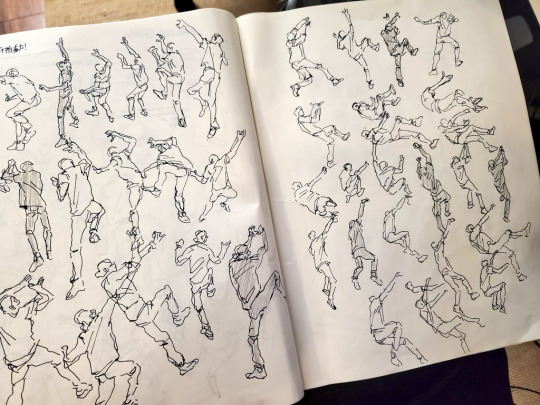
because they’re climbing you actually get a lot of interesting angles LOL... good study of pose-to-pose relationships too, actually..
2) Practice dynamically. If you can develop the eye to figure out where your drawings are lacking, you can practice with those weaknesses in mind. If you realize you don’t really understand the structure of a foot or the back of the head or the back when it’s arched, look up references and practice those things specifically. Sometimes it’s not in the specifics but the general - if you realize you have a hard time proportioning out the figure, draw guides for yourself and set goals to draw proportions before details. Stuff like that.
3) Box Trick. This is just the simplest way to get a set of guidelines down for perspective on the human body the same way you put down guidelines to figure out where the eyes sit on the head LOL.

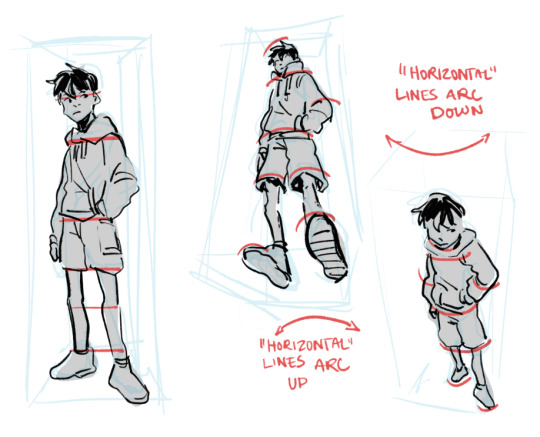
but here’s something to keep in mind regardless: perspective is a game. You’re tricking the eye into thinking something is close or far when actually its just sitting on the same 2D plane as everything else. You can do the math and make all the guides you want but at the end of the day its either going to look convincing or its not. And being convincing is a lot less about being accurate and a lot more about confidently selling your point. So don’t sweat the calculations of proportions, make hands or heads or feet as big as you feel is right and trust your eye and your gut over your brain.


Hi, yeah sure go ahead! As long as you link+credit me, I don’t mind my work being used for non-profit purposes. Especially fanart like.. I don’t even own these characters LOL. Just, if you edit my art, please don’t use it to perpetuate like...hate speech or even edgy politics... unless they are edgy politics I have explicitly endorsed LOL. If you’re ever on the fence abt it feel free to ask, of course!


TYSSMMM yeah ideally I guess its just ? group therapy LOL? I feel like actually Ryuji, Akechi, and Haru are characters we see very rarely interact and when they do they seem very alienated by each other?? So I think it would actually be great for them to chat LOL they have a lot in common especially the fondness for direct action.


VERY NICE THINGS TO SAY TYSMMMMMMMMMM
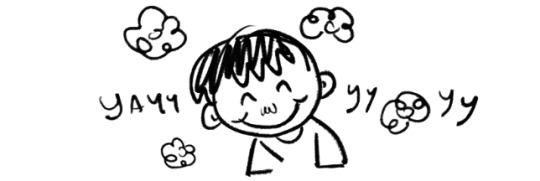

I guess since I was old enough to hold a crayon? Doesn’t every kid draw?
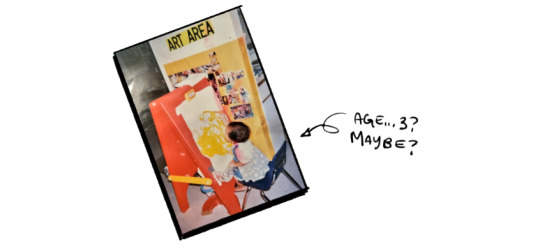
But if you mean when I started seriously drawing and trying to get better.. I guess I started carrying a sketchbook when I was 12-13 years old and I’m turning 25 in a couple days so it’s been 12-13 years about. I don’t believe that years have any huge bearing on art progress though. You can be drawing for 50 years without ever deepening or widening your skill set, if you stick to the same old patterns day in and day out. Similarly an artist who is proactive with learning new skills and targeting their weaknesses can improve in leaps and bounds in a matter of weeks.
The style I currently use for painting, I only really started using.... about 3 years ago? When I was a senior in college.

but i wouldn’t say I’ve “““mastered”““ it and I doubt I really ever will because I don’t think that’s the point... I’m constantly changing things depending on how I want a painting to look or the way I want it to feel... or how I feel on any given day LOL

the thing about art style is I don’t think it’s actually something you have to work on or “find”. An artist should change the way they draw depending on the subjects or techniques they want to explore. If I wanted to convey comedy, I’d draw characters differently from how I would if I wanted to portray drama. And if I wanted to focus on lighting I’d paint differently from how I would if I wanted to focus on the details of the human form. When I was drawing a lot of digimon fanart earlier this year I drew differently from how I’m drawing now while putting out a lot of persona 5 fanart LOL - even when the content is similar the characters have different gestures and different tone that I convey through any number of things, proportion, rendering, edge definition, color range, etc etc.
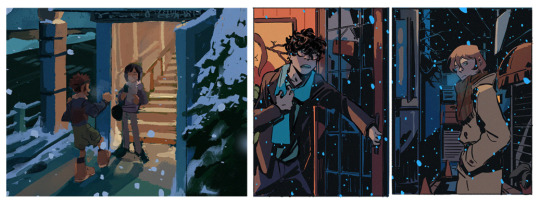
as you experiment with techniques and approaches undoubtedly there’ll be some you’re naturally better at or more interested in than others. and i think that’s what a person’s “art style” really is, the stuff that you gravitate to and come back to over and over even as you transform and explore.
not sure if that makes sense but.. that’s my two cents, anyway.

yea hit me uppp dude [email protected] lmk what you want and I’ll give you a quote
195 notes
·
View notes
Note
Bro how are you so good at making shit. You can just want to make something and suddenly you can and you have it now. That's so badass. I want to learn how. What the fuck dude. I love your content
Thank you! Seeing repeat likes on my stuff is instant serotonin for me. :)
So, on Making Stuff. Being older helps, in that I have built up some experience and resources. But if you’re serious about wanting to learn how to do Stuff, it’s all about being good at How to Teach Yourself.
Advice under the cut.
I could talk about this a long time, but here’s the salient points.
How to Teach Yourself to Make Cool Stuff
1) Cultivate your tastes. Just collect a bunch of shit you enjoy. Pinterest and tumblr are great for this because you can organize stuff by tags and add your own commentary.
2) Describe why you like the things you like. Get as specific as you can. Don’t just say, “I like the color palette”. What about the colors do you like? What kind of tones are they? Do they contrast? Are they unusual for the subject matter, materials, or style?
Challenge yourself to write 10 specific things you like about every thing you favorite/re-pin. Also include some things you don’t care for or would like to see done different.
Be specific -- you’re trying to figure out how your brain works, and learning how to describe your tastes will help you research how to make similar stuff. This is hard, but you gotta do it!
3) Learn what materials, tools, and techniques are and what they’re called.
You’re learning names of stuff not to ace any pop quiz, but rather, to build your vocabulary so you can ask better questions and do better research.
How do you learn this stuff? Asking people is helpful, yes, but what if you don’t even know who to ask yet? Search for content using the words you know now -- you’ll expand your vocab as you go. Stuff like “leather bag diy” or “how to draw with a digital tablet”. Don’t be afraid to use super basic search terms. If you don’t know what a grommet is, a search for “hardware for holes in leather” will lead you to the term pretty quickly. Just keep slamming search queries against the wall until you start getting consistent results.
Then:
Watch videos of people making things you like.
Read forum and other social media posts.
Read tutorials on sites like Instructables, even if they are beyond your skill level.
You’ll notice I haven’t suggested buying books and tools yet. This is because you are still figuring out what will even be useful for you. Just be a sponge.
4) Seek out the pros and learn from them. As you’ve been doing your research and collecting inspiration, you’ve probably noticed certain names coming up over and over. See what sort of training they offer. Classes are ideal, but training can also take the form of videos and books.
For example, Tandy Leather offers in-person beginner’s classes at their stores for pretty cheap (about the cost of the tools you get to keep). Black Raven Academy does a pre-recorded leatherworking video series, with access to the instructor throughout the course. If you’re into EVA foam, Evil Ted doesn’t do classes, but has very comprehensive (and free) videos. Some Makers have books. Etc.
You want to look for professionals who use projects as a means to teach you techniques you can apply to your own work. It’s the whole “learning a recipe” vs “learning how to cook” philosophy.
Also, don’t limit yourself to people who make exactly what you want to make -- I love Kamui Cosplay’s content because she shows off some very useful techniques. Ironically, I probably wouldn’t cosplay as a single thing she does, because I have different interests. I still admire and learn from her work, though.
Don’t go hog wild buying books and supplies -- pick a professional or two and absorb their content until you feel almost confident to try making something.
5) Make a Thing! I said “almost confident” in step #4, because perfection is the enemy of Good. Just jump in. You’ll probably suck, that’s ok. Try to complete the Thing. Small or Big, you know yourself better than I do on what motivates you best.
6) Review your Thing. You know how in step #2 you learned how to be specific with what you liked and didn’t like? Be specific with BOTH about your own work. Know how in step #3 you broadened your vocabulary? Now use that to research how to make your Thing better. I’ll bet you tons of folks had similar learning experiences and got good advice.
7) Practice often, but practice thoughtfully! Practice isn’t just repetition. Building motor memory is important, but it’s meaningless if you don’t practice thoughtfully. The purpose of practice is to figure out root causes of your problems and the best ways to correct errors and reinforce what you do well. I play the oboe professionally. When I practice difficult passages, I don’t just start slow and speed up, one metronome click at a time. That’s how you get frustrated and train your fingers to screw up every damned time. So, I’ll play starting in the middle of a run. I’ll play in a different key. I’ll play with the entirely wrong rhythms. I’ll memorize it. I’ll play when I’m dog tired and standing on one foot. I’ll do a bunch of things to figure out exactly why something is hard -- it’s seldom as simple as “it’s too fast”. (Usually it’s because I’m uncomfortable with a fingering, my hand position is bad, I’m being lazy and don’t even know what all the notes even are, I’m not using enough wind, my oboe is out of adjustment, etc.)
15 min of thoughtful practice is so much more valuable than hours of rote exercises.
Practice can be fruitful, too! When I do projects like design matchbooks, stickers, and stamps? That’s a form of practice for me -- you can practice skills by making things. And sometimes the most important skill to practice is finishing things.
Be honest with yourself and always remember to not focus solely on the negative -- always look for stuff you like about your creations.
8) Experiment! Need to substitute materials? Have a cool idea? Experiment, review, and iterate.
9) Rinse and repeat. Making stuff is all about continual learning, and that always starts at the beginning. Go back to Step #1. And even learn about Crafts you don’t plan to participate in, because inspiration is everywhere. :)
#goatpants-satyr#serious talk#teaching#I taught oboe for 20 years but always told my kids I was really just teaching them how to teach themselves#that is the best thing any teacher can teach you#the real purpose of school imo#we don't pop out of the womb knowing how to practice#that is a skill you gotta learn#so don't feel bad because you will also suck at practice at first#long post#text#when I joke about not knowing what I am doing there is truth there#almost every project is a learning experience#I purposefully make things I don't know how to do (yet)
60 notes
·
View notes
Photo
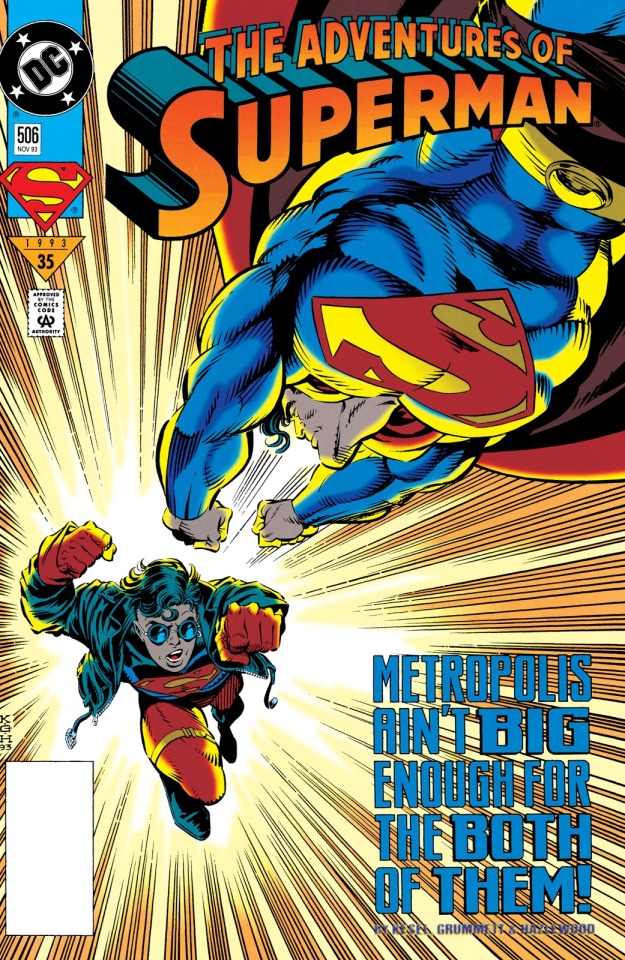
Adventures of Superman #506 (November 1993)
Superman vs. Superboy! I mean, vs. Superman, since the Kid still insists that Superboy is definitely NOT his name and never will be. The two Supermen meet while the younger, radder one is dealing with some sort of deformed flying babies that are trying to kill him, which is the sort of thing that happens to you when you wear an “S” emblem on your chest.

These turn out to be deformed flying babies THAT EXPLODE, but the Kid is able to push them away with his (very non-Superman-esque) telekinesis powers. He then deduces that these things must have come out of Project Cadmus, the top secret genetic experimentation facility that created him, and brushes off the elder Superman to get back at those geeks by doing what he does best: being a brat on live TV.
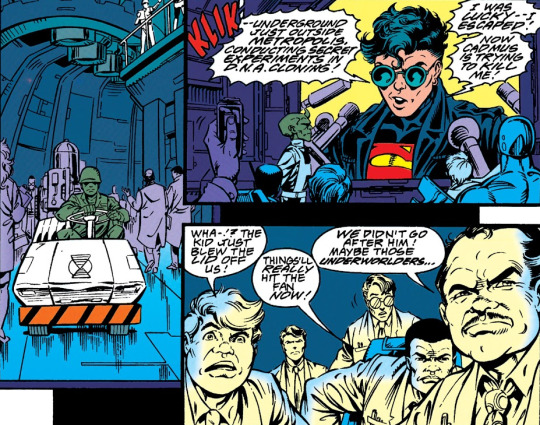
So I guess the “top secret” part of Cadmus’ description is no longer accurate, thanks to the Kid. On the other hand, I kinda feel like the people of Metropolis deserved to know that there's a nearby government facility churning out genetic atrocities into their sewers.
The Cadmus gang sends Guardian to bring their wayward creation home so they can talk to him. Obviously the Kid isn't very interested, and for a while it looks like we might get the fight scene teased in the cover, but then Superman the First convinces Superman the Second that he should at least hear them out. And, while at it, ask Cadmus to tell him exactly what the hell he is. If he’s Superman’s clone, why does he have those weird TK powers? The Kid agrees, but... he doesn't like the answers he gets.
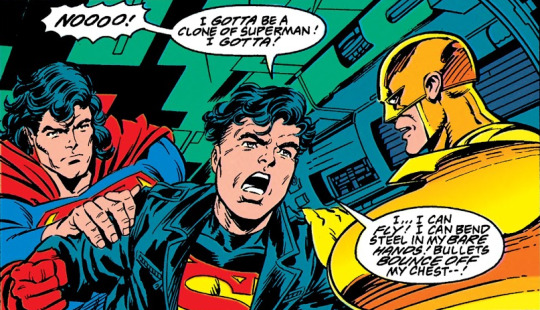
The Kid finds out that he's NOT a clone of Superman since, as established a while back, Kryptonians are damn hard to clone. So, since Cadmus was determined to create a new Superman after the original appeared to be dead, they instead took a clone of a regular, non-super man and genetically modified it to approximate Superman's powers (for instance, translating Superman’s “aura” into a telekinetic field). But who was that human DNA donor? Surely it was someone good and cool!
Just after the Kid wonders that, the quite evil and deeply uncool Director Westfield bursts into the lab and demands that this "super-punk" be taken into custody, probably so they can flush him down the toilet like Cadmus' other failed experiments. Superman makes Westfield see that making Cadmus' whistleblower disappear wouldn't look very good right now, but they can't just let him run around unsupervised. So, at Guardian's recommendation, the esteemed telepath Dubbilex is assigned to follow the Kid wherever he goes. I smell a sitcom! (Or a spin-off comic.)
As a last order of business, the Kid decides to give Superman his trademark to the Superman name, which his manager Rex Leech doesn't take too well. So what are they gonna call this teenage “S” emblem-wearing hero now? Superman has an interesting suggestion: SUPERBOY. Our young friend still isn't a fan.
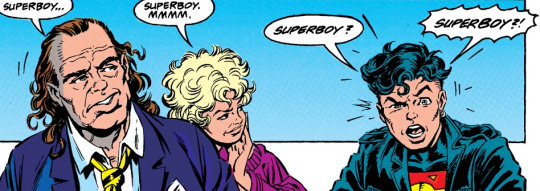
But after storming out and thinking about it for a couple of pages (and trying out the name on some guys robbing a jewelry shop), the Kid realizes he's "earned" the title of Superboy and accepts it. Character development! And just in time for his solo series. ("That Non-Superman Clone Who Also Calls Himself Superman" wouldn't look good on a cover.)
Plotline-Watch:
The final page shows a shadowy figure shaped like the recently introduced Bloodthirst outfitting someone with a weapon-teleporting gizmo, then calling him "Bloodsport"... except that this dude is quite paler than the Bloodsport we met way back in Superman #4 (in an issue inked by current writer Karl Kesel, so you'd think he'd remember the character). This looks nothing like Idris Elba! What gives?!

Superboy is still bummed out because his friend Tana Moon left Metropolis without telling him where she was going, which is now known as "ghosting". In the end, Rex talks about sending Superboy on a promotional tour to establish his new brand, and the first destination of that tour will be... exactly where Tana went to hide from Superboy. This is now known as "time to get a restraining order."
Clark Kent is slowly morphing into a hipster the longer he rooms with Jimmy Olsen. For a long time I assumed all the bands listed in the panel below were made up, but turns out the only non-existing ones are “James Rock” and "Axel Rose". Luckily, Superboy was happy to give Clark's old apartment back to him (apparently only Pulitzer-winning journalists can afford it), so Jimmy won't hipsterize him for much longer.

Westfield gladly assigns Dubbilex to Superboy because it means there won't be a telepath at Cadmus to read his thoughts and find out about his evil plans (like sending the ugly flying babies after Superboy). Very clever, Westfield! Except for the fact that he thought that right in front of Dubbilex, who clearly "heard" the whole thing.
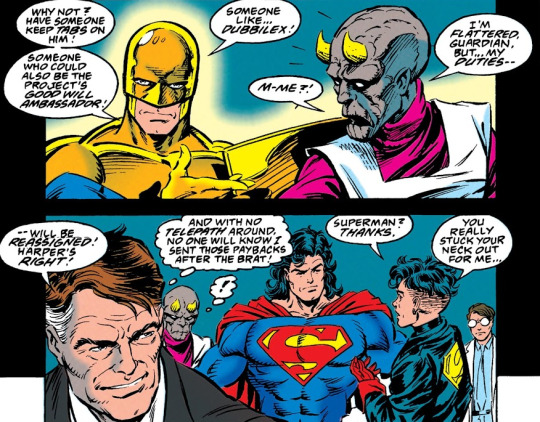
Incidentally, there's an apparent error in this issue when Superboy thinks "They won't take me without a fight!" and Guardian shows up and says "That's too bad, son. Because I don't want to fight you." How did Guardian know what Superboy was thinking? Obviously, Dubbilex patched Guardian through to Superboy's mind to assist in finding him. Now where's my damn Baldy Award?!
Is it me or is this page reminiscent of the cover to Superboy Prime's first appearance during Crisis on Infinite Earths?

Patreon-Watch:
Special thanks to your Patreon pals Aaron, Murray Qualie, Chris “Ace” Hendrix, britneyspearsatemyshorts, Patrick D. Ryall, and Samuel Doran, and welcome aboard to Bheki Latha (our first $6.50 patron ever!), Mark Syp, and Ryan Bush! You are all excellent. This month they got to read a long-ass post entitled 45 Things I Learned by Reading the “Death of Superman” Novel (Part 1), in which I talked about the stuff Roger Stern added to the canon in the first part of the Death and Life of Superman book. This includes Superman’s private thoughts on the JLI (and Guy Gardner in particular), what Lex Jr. calls Supergirl in bed, and Professor Hamilton getting romantic. Find out more at https://www.patreon.com/superman86to99
But now: the Don Sparrow show! Take it away, Don.
Art-Watch (by @donsparrow):
The end of an era, at least temporarily, as Tom Grummett draws his last Adventures of Superman issue, moving onto Superboy (and I think still doing Robin at this time?) with Karl Kesel. He’ll return for the quarterly Superman: Man of Tomorrow and other things, but it’s a long gap until he does.
A pretty good cover, with Superman and Superboy about to tussle. Though it can be seen as cheaping out on the backgrounds, I always love radial rays as an effect.
Inside the issue, we have a great splash page of Superboy getting attacked by botched clones, and I love the gesture here—having his head snapping away from the camera adds to the motion and action. Great stuff.

Though he won’t be drawing her again for a while, Grummett excels at the new, shorter-haired Lois in these pages. Superman soaring to the skies is a great panel as well, and I especially like the way his cape and fist slightly break the panel barrier, giving it a sense of motion, again.
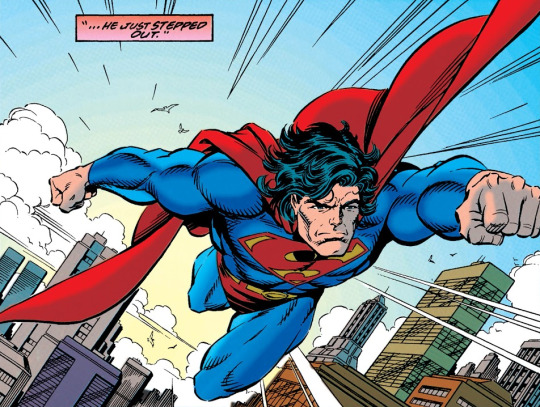
The sequence of Guardian acrobatically flipping from one ledge to another is very well drawn. Ditto the splash on page 13, where Superboy loses his temper. The body language in this whole sequence tells the story very well, as Superman is calm and patient, confident in his ability not only to reach Superboy with his words, but also withstand him physically.
The way Superboy snaps the carpet, but controls it mentally with his Tactile Telekinesis is a great example of his unique powers in use. It reminds me of a technique they tried on the CW Supergirl show (but almost immediately abandoned) where they made like the Kryptonian fabric of their capes was like “smart fabric” and could be used as a weapon.
Lastly, the dreamy, child-like expression on Superboy’s face during the Peter Pan exchange is wonderful, and a fitting end for Tom’s run on the book. [Max: You mean the William Shatner exchange, Don.]

STRAY OBSERVATIONS:
I almost never like it when they reference pop culture stuff in Superman comics, particularly music. Karl Kesel isn’t the worst offender in that department (that would be JM DeMatties a few years down the line, who had Clark Kent bizarrely asserting he loved the Beastie Boys) but Clark’s discussion with Jimmy about an apparently fictional musician working with a rolodex of early nineties names makes me cringe (as does trying to imagine how awful a “Hip Hop Lyle Lovett” or “Grunge Frank Sinatra” would sound).
The car poster on the wall of Jimmy’s bachelor pad looks for all the world like Robin’s Redbird, also a Tom Grummett creation. (Fun fact: Tom once told me he still gets {very small} royalty cheques from the Batman & Robin movie, because Robin’s motorcycle was called the Redbird, though that might no longer be true with Paul Levitz no longer in charge of such matters.)
Superboy (in no less than his third time calling those pink creatures “spuds”) references John Candy and Joe Flaherty’s “Farm Film Celebrity Blow Up” where the guests would frequently “blow up real good” and it does my SCTV loving Canadian heart good.
It’s interesting (and a little sad) that they again note that Superboy knows things (pop culture, etc) without ever having experienced it. I feel like there’s a lot they could do with this concept.
This issue reads very much like the end of the Superboy “Reign” issues, as Superman is more of a secondary character to the kid. All of it begs the question of why Superman, or Guardian put up with Cadmus. Superman has said in previous issues that he has moral problems with how Cadmus treats life with their cloning experiments, and they’ve attacked him in the past (and also stole his corpse!) so other than the fact that it’s a launchpad for Superboy’s series, there’s really no reason any of these heroes should associate with Cadmus. Especially Guardian, who comes off as little more than an errand boy here. He wants to bring Superboy in, but won’t promise Superboy won’t be harmed or imprisoned?
Nice to see Superboy return to his “Slammin’” catch phrase!
An interesting bit of foreshadowing when Superboy asks Big Words whose clone he is, and who immediately enters but Westfield. [Max: That’s right, Westfield! Not Luthor! Sorry, sorry.]
#superman#karl kesel#tom grummett#doug hazlewood#superboy#project cadmus#paul westfield#dubbilex#guardian#carl packard#rex leech#roxy leech#bloodthirst#bloodsport#hip-hop lyle lovett#grunge sinatra
26 notes
·
View notes
Text
I wanna connect the ideas in this post with the ideas in this post because they seem relevant to each other.
to give a basic idea of what's in each one, the first is a post that talks about how homestuck is notable as a creative work that effectively uses the language and format of the internet, in a way that resonates well with people who grew up online. my addition extrapolates to talk about how this quality also made homestuck's style of content creation appealing for others to use, and spawned a lot of creativity from the fans. basically, homestuck is a collage, not just of images, but of methods for delivering information to the audience. it uses a broad variety of experimental techniques, but the purpose of them is to make storytelling accessible. in order to convey an idea, you can use any method you want... whatever suits your purposes. by constantly varying the type of art, writing, and formatting that the story uses, it keeps the story from getting boring for the author and the audience. varying the quality and style of the visual art also implicitly accepts and encourages any kind of artwork, at any level of skill or effort, from fans. and at the same time, the story pioneers new techniques that I legitimately haven't seen used before. at some points it even leverages the design of the web page itself to service the story... it's awesome. this gets people thinking about how to tell stories in non-traditional ways, and further encourages the act of being experimental with your storytelling methods, and having fun exploring your chosen medium.
the second link is mostly just me talking about the merits of homestuck's early acts, and at one point I put a particular focus on the idea of science in homestuck. specifically, I was talking about how homestuck handles science in a way that feels very childlike, which is a positive remark. when you're learning about science in school as a kid, efforts are made to present the material in a way that is fun and interesting... and you're given a lot of tools for exploration within the context of science classes, which a lot of people don't really experience having outside of a school setting, if they aren't going into some branch of science for their career. I was observing that homestuck's aesthetic kind of calls to mind the feel of learning about science as a kid... something about the stark readability of the objects and characters, and the bright color coding of things that are important.
the connection I want to make between these two posts is that homestuck hinges a lot of its interest on the concepts of exploration, and creation. it holistically includes a lot of different themes and ideas, and it does it in such a way where the characters don't have to make it explicit... more often than not, you'll end up thinking of it yourself. homestuck simply introduces elements, and lets you form your own ideas. it puts a lot of stuff out there, and links it all together in this messy web of interconnectivity.
for example, check out this post where I added some commentary about the punch card alchemy system, and how it links the concepts of technology and philosophy. the idea is that captchas determine your humanity... but unlike real captchas, which do this by making you read something that a computer can't read, it instead makes you think in a way that a computer can't think. in order to give you access to items, this crafting system requires philosophical justification for the creation of said items. grist isn't just made up currency that exists to make you work for what you make... the amount of it that it takes to make something is only high if you think that the object you're making should be too powerful or important to be gotten for cheap. you prove your humanity by having a psychology that can assign the object meaning, and thus, value.
or what about the broader themes of biology and mythology in homestuck? there are many mentions of genetics... the goal of the game is to produce a universe via breeding, and there are the origins of each of the kids, or the fact that the chess pieces that fight on Skaia's battlefield are made in test tubes in the labs in the furthest ring... etc. but this theme also exists symbolically in the players of each session. they are people who bring their identity with them into the process of making a new universe. each player is given their own planet, which is responsive to the person it's meant for, and features a personal quest for them. and once the new universe is made, the players will preside over it as deities, and help define its culture with their values, interests, and personalities. in this way, homestuck blends the concepts of biology and mythology. in a biological sense, the kids provide the universe with traits. if they are strong/adaptable/resourceful enough to win their game, they get to pass on their influence to a universe of their own. this is why it is relevant that all the players' chumhandle initials are some combination of A, C, T, and G, which are the letters denoting nucleotide bases in DNA. but this concept also applies to heroes going through trials or completing quests to prove themselves worthy of being known as heroes. SBURB's lore automatically mythologizes the players in the role of legendary heroes to the consorts and carapacians, which pushes them to step up to the task of earning their title, and in doing so, complete the game's objectives... and the game gives them the tools to do it.
really, science, mythology, and religion all wrap into each other here in terms of the way things are named and explained. the punch card system and the frog breeding are both referred to as "alchemy" at various points, which indicates both magical and scientific roots. and the highest title that the players aspire to obtain in the game is "god tier" which implies a sort of religious connection between the players and the game's native characters who know them as legends. the magical abilities that the characters display are ambiguous as to whether they are magical, divine, or something else entirely. a lot of them are defined heavily by a character's personality and identity. the malleability of the different elements that homestuck juggles works entirely in its favor... and all of it is geared towards this sense of growth and creativity.
in homestuck, these things exist on micro and macro levels. the growth of one kid into a slightly different person as they get older, vs. the growth of an entity that will encapsulate the universe. the creation of a piece of music, a drawing, a story, a machine, a person, a plan, a planet... it all just keeps escalating, but it's all rooted in specific characters doing specific things, so we don't get lost in it all. the characters bring it all back around, letting us focus on their smaller actions while the bigger plot remains in motion. and all of this exists at the same time as all the surface level reasons to enjoy homestuck. the comic is funny, and charming, and made to be enjoyable as that. but the fact that the broader elements color the tone of it all, leaves you with the impression that there is a lot of potential in every situation. potential places for the characters to go, or things for them to do, or people for them to talk to, or things for them to make, or even ways to grow and change themselves.
and there's potential for you too. you could throw your ideas at the wall to see what sticks in this exact same way. part of reading homestuck is feeling a sense of recognition and identification with the characters. many of them are based broadly on the kinds of people who make up homestuck's audience. with interests in things like music, art, writing, RPing, programming, playing games, watching movies... they're meant to represent you, in part as parody, but in part as a way to make you feel seen and included in this narrative. as lofty as some of these concepts may seem, the people who engage with them in the text are a bunch of dumb awkward teens. you are at least as accepted as they are, and people love these characters a lot, often in spite of/because of a lot of cringey qualities or major character flaws. homestuck is here to tell you not to be self conscious. play around with your world. make your art. write your story. think your thoughts. be funny and laugh at stuff. don't be afraid of doing it badly.
this is what an accessible creative process looks like.
11 notes
·
View notes
Text
How to Sew YOUR size
Being a cosplayer is challenging for many reasons. Expense and flamboyant designs can be tough to deal with, but even if you go to that sketchy costume site to buy your costume there is one more challenge to face...sizing. As a tall and chubby woman, I’ve always found it nearly impossible to find my size. Even sewing patterns seem to have the problem of making “average” size ranges that don’t fit right. Anyway, the point of this tutorial is to teach you guys how to sew basic patterns to fit you!
NOTICE: If you like to buy sewing patterns and just adjust them to your size, that’s fine too!
Step 1: Break it down now, ya’ll!
The first step to any project is breaking down your outfit. I’ll be using my Litwick cosplay for this. I find it easiest to look at (or create) a reference, then draw it piece by piece on a separate paper. “Okay, so how do I know what is and isn’t a whole piece?” You don’t. Unless you find a very detailed character sheet, the number of pieces is completely up to you.

As you can see, I made views from the front and back. Colors and designs changed while I was sewing this cosplay, but such is art. Also, it really helps to look up similarly shaped clothing online to help you draw a flat of your clothing. Flats are exactly what they sound like, a 2D drawing of clothing. This is where you’ll lay down seams, buttons, and just get a general idea of the shapes you’ll cut out for your outfit.
Step 2: Shapes and Measurements
No matter what size it is, clothing will usually be made up of a few shapes. A size 4 shirt will be made of the exact same shapes as a size 26 shirt of the same type. With this information in mind, break down each article of clothing into basic shapes. The halter top on the top of my dress was made of stretch cotton with 4 shapes: collar, back left, back right, and front. I admit I altered this from a sewing pattern, but we’ll get patterns in a second.

The vertical lines with horizontal marks are seams. This isn’t necessarily a flat as much as it is a diagram, really.
Also, I live by measuring tape. It allows you to go around round objects (like literally anything on your body) without all the hard math! If you don’t have one, I advise either getting one or magically become capable of math. The rest of this tutorial uses measuring tape.
In the fashion world, there are basic areas for measurement. If you’ve ever gone to a tailor, these are the same areas they’ll measure on you to tailor your clothing. This picture will help you locate those areas.
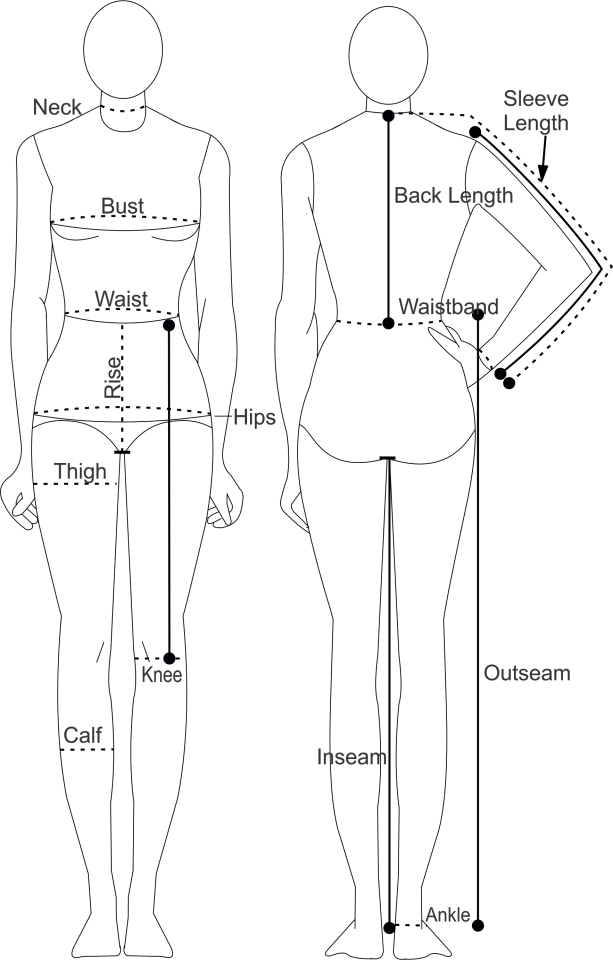
Once you know your sizes and the shapes you’ll be making, you’re ready to start!
Step 3: Making your pattern
You have your reference, your flats, and your measurements. Time to mush them together and splatter them on some paper. I use wrapping paper with a grid pattern. Cheap, easy, maintains better than those cheap toilet paper-like sewing patterns from Joanns.
Always make a mock of your clothing with cheap material that’s similar to your costume fabric. Mock garments allow you to save good fabric and make alterations.
Patterns are actually a lot easier than they seem. If your neckline is supposed to go (comfortably) around your neck, measure your neck, divide by the amount of pieces you have. I had three pieces for the halter top. Because my front and back pieces were symmetrical, I just cut two pieces and split one down the middle. Why does that matter? It matters because it means I divided my neck circumference by two, then split it into three. If you measure the front piece both of the back pieces, it still adds up into the total of inches around your neck. If it doesn’t? Trim it down or re-math and re-cut.
For your bust and waist, take your bust and waist measurements and alter the shape to those measurements. Commit this to memory, you’ll use this technique for ALL of your measurements (or at least until you learn a more formal technique). Using a ruler, draw a vertical line on your paper that matches the length of your garment. Now create horizontal lines (starting from the middle number of your measurement i.e. 5 inches, line the vertical line up with 3) and draw a line matching the HALVED total of your neck. Measure from your neck to the center of your bust. Draw another horizontal line at the end. Next, use a ruler to draw the shape of your garment. I freehand curves and alter them as I go (HENCE THE MOCK MATERIAL). In general, though, it’s a better idea to use a curved ruler. The point is that you’ll want to hit every end point of your horizontal lines. Depending on your measurements and material, you may have a few curves in your originally straight, blocky, shape. That’s natural.

Now, the bust/waist/hip measurements are a bit...exaggerated, but I wanted to show that it’s perfectly fine to start with the small shape on the bottom and come out with a slightly curvy or straighter pattern.
Depending on your material and pattern, you might need to add darts to make a tighter fit. Darts are triangles or diamond shapes made on a pattern, that act as folds to make a garment more form fitting. You’ll want to test placement of your darts through your mock up. There’s a few places to place darts, but the places I’ve used them are: bust to armpit, stomach, and back.

Step 4: Sew and alter
If you’ve decided to make a mock first (as I so wisely advised) your next step is to sew your pieces together and alter them to fit better. Alterations could include: Adding or subtracting the size of your patterns, adding or releasing darts, planning for zippers/buttons/closures, etc. Once you’re happy with your mock garment, seam rip the pieces apart again and use them to alter your original pattern.
NEVER CHEAT YOURSELF QUALITY TO MAKE UP FOR LOST TIME. If you mess up and you have 3 days left until that convention just go without a costume! I know going to a con without a costume when you’ve worked so hard sounds heinous, but trust me, it’s better to make up for your mistake for a future con than to sew over it and pump something you’re not happy with out.
Ta-da! You have your own pattern to fit your body! Now you can sew up the real thing.
DIsclaimer: I am but a humble space slime. I cannot do more than simple math. I also admit that I have no formal training. This tutorial is how I taught myself to sew my own costumes. It took me years to perfect this technique. It’s a little long winded (probably a lot more steps and alterations than a pro would have), but I decided to put this out there for anyone who wanted to try their hand at sewing. Good luck you guys!
Pro tip:
The amount of pieces for the garment decide the size of which you cut them. If you have two pieces, a front and a back, divide your measurements by 2. If 4 pieces, divide by 4. ALWAYS ADD IN YOUR SEAM ALLOWANCE (.25 inches)
Pro tips:
If there’s belts and buttons galore on your costume (and you aren’t a COMPLETE perfectionist), just sew them down. Not every belt or button has to be functional.
More or less pieces depend on the effect you’re going for. If you have a few layers of shirts or jackets, it will save time (and you from heatstroke) if you just create the illusion that you’re wearing more than one piece of clothing. You could also create each piece and have that volume of multiple articles of clothing under that jacket. Your choice!
#cosplay#sewing#cosplay tutorial#sewing tutorial#anime#games#plus size#television#cosplay community#crafts#cosplay crafting#cosplayer#anime costume#cosplaying#costume#costumes#beginner tutorial#cosplay for beginners
96 notes
·
View notes
Text
Unsolicited Book Reviews (n3): The Sunne in Splendour
Rating:
⭐️⭐️⭐️(+1/2?)

Even before I had an account, I tended to go to tumblr to see people’s opinions before buying a histfic. Certain books are either severely underrepresented, where I feel like there needs to be something on them, whereas others, though talked about enough, something more can still be said about them. So for my quarantine fun, I have decided to start a series where I review every medieval historical fiction novel I read. Hopefully, it will either start interesting discussions or at least be some help for those browsing its tag when considering purchasing it.
TL;DR: Keep in mind that I’m harsh with my ratings. I don’t expect my historical fiction to offer some sort of insight about the human condition or be some perfectly manicured prose, but this book’s biggest detriment was its lack of depth. Some scenes packed a serious emotional punch, but then again I am attached to this era and given the length, it would be insane not to. I learned a lot - no lie, but while my background knowledge on the wars of the roses has become enriched, I feel no closer to Richard.
Plot: We follow Richard III from a young boy at eight right before the catastrophe that was Ludlow to his death and a few years after. This story seems to be told through omniscient third person point of view, which creates issues when it comes to voice - a lot of the characters sound the same (John ‘Jack’ Howard, Francis Lovell, Richard Catesby to name a few). This is only a natural consequence of the sheer amount of people Penman chose to portray. I’m honestly still grateful for this as I was not a fan of Richard III’s POV, but really enjoyed Richard Neville Earl of Warwick’s, Margaret of Anjou and Cecily Neville’s. Everytime these three were the center of the chapter, it was truly enjoyable and multi-faceted which comes to show that Penman is capable of writing complexity when she wants to. I would also like to add that the author’s knowledge of medieval life (e.g. the food, the dogs, the nature of battles) was a high point of this novel and did something to counter-balance the rampant late 20th century flavour in this novel. She tries way too hard to adapt a medieval man such as Richard to our modern values to propagate her Richardian Agenda, which ultimately underscored this.
It must be said though that the author clearly did her research as most of what she said regarding minutae such as: what day of the week it was, where the characters were at one time, details of documents, who did what in which battle, what laws were passed etc... I had just come back to this time period after some years and I thought I knew all there was to know, yet, here comes this book which springboarded me into a wealth of new research - I suppose I am grateful for that. However, do not let that delude you into thinking it is comprehensive. There were historical innacuracies which I can only guess were intentionally made for the sake of the author’s Richardian goal e.g. Anne Neville being forced into her marital duties when historicalMargaret of Anjou made it clear that there would be no consummation until Warwick would prevail at Barnet, Isabel Neville being ‘abandoned’ by her husband in France when really it was only about 4 months they were apart and it would have made no sense for Isabel to sail with an invasionary force, Richard III abolishing benevolence tax because he thought it unfair as opposed to the reality which was that he had failed in his initial attempt to raise them because the population opposed, Richard III allowing the marriage between Jane Shore and Thomas Lynsom when in reality he had initially opposed it... Historical fiction is entitled to innacuracies but given that the author made it clear in her afterword that the only time she strayed was setting a scene in Windsor as opposed to Westminster, it is dishonest to conceal the aforementioned blips, especially when they are so unobvious that it would take a seasoned enthusiast to spot them. As you can tell they either do have a negative bearing on Richard’s image as a saint or show detractors in a positive light, clearly neither that which she was in a mood to explain away.
Characterisation: I can not stress enough how well Cecily Neville was portrayed, every scene she was in, I felt. She tends to be a very difficult character to get because of the whole illegitimacy rumour which casts shades of doubt. She was proud but also pious, subservient but also commanding... just an incredible woman of gravity. I enjoyed Warwick in all his flamboyancy as well and Edward IV was masterfully portrayed as the intelligent but forgiving man that he was. You could clearly see how despite his indulgent character, he knew when it was time to be serious, it was a joy to read the scenes where he strikes people into subserviancy. Anne Beauchamp was also quite a treat for the little time we had with her.
There were also some portrayals of mixed quality: George Duke of Clarence for one, his warped sense of humour and charm were well presented, his unpredictability adequately captured. The issue I have though is that no man is unpredictable to themselves and while it may make sense for other characters to see his temperaments as those like a weather vane it would make no sense for it to be this way in the chapters where he is the POV. Penman’s basically wrote him off as crazy (I mean literally mad) for the majority of the story which is utter tripe given that the whole madness angle is a modern invention. I won’t write more on this now as it deserves its own post (btw if anyone wants me to elaborate on anything I said so far send me an ask). Last thing I will say though: the last scene we have with him is utterly tragic and still sticks with me today, honestly the best writing in this novel was during the ‘Anne’ Book and ‘Protector of the North’ in the years surrounding George’s death. Speaking of, where do I begin with Isabel Neville and Elizabeth Woodville? Their marriages with Richard’s brothers are portrayed negatively for no other reason than to set up Richard and Anne Neville as a perfect love story. This story-telling technique is cheap as hell and I did not expect to find it in a novel so highly acclaimed for its ‘quality’. Let me make this clear: The marriage which was hailed as a love match at that time was that of Elizabeth Woodville and Edward IV. Anne and Richard could have been just as much a marriage of politics as George and Isabel’s, or the latter’s just as much a love match. George fought for Isabel just as much, if not more than Richard did for Anne, George stayed loyal for a surety whereas Richard’s bastard John’s conception may have coincided with his marriage according to Hicks, Marrying Anne was highly advantageous for Richard as marrying Isabel for George... I could go on. Therefore, why is Isabel constantly described as wretched, miserable and at one point abused(!) by her husband whereas Richard was nothing but gentle to the happy Anne. The Mary of Burgundy proposal story is often cited as proof that George only cared about power... but what about Richard’s proposal to Joanna of Portugal one month after Anne died? This may sound minor but it’s a perfect example of the author trying hard to make Richard a modern romantic figure which he wasn’t. I think he may have loved Anne Neville, but that doesn’t change the fact that he was a medieval king and made marriage provisions after her death to secure the succession. For a 800+ page novel about Richard III some seminal pieces of information were left out such as his seizure of the aged Dowager Countess of Oxford’s Howard fortune, the mysterious circumstances in which George Neville Duke of Bedford died young and unmarried after becoming his ward. All in all, do not let the wonderful historical detail fool you into thinking this is a complete account of Richard III’s day to day life.
Don’t even get me started on the Woodvilles... They were all treacherous villains and social climbers who belonged in hell. EVEN ANTHONY WOODVILLE - what has he ever done to Penman or anyone? All scenes with Elizabeth Woodville at the beggining were bedding scenes pretty much, which shows that the author saw her as nothing more than a heartless seductress. There was even a point where Edward in his rage said: ‘you would lie with a leper if it meant you becoming Queen’ and I was just shocked at that. I was further shocked when her daughter Elizabeth of York was musing that if her mother had been a good wife her father wouldn’t have needed to stray and I was just like... ‘I thought we were trying to be sensible in this book 0_0’ - How is it appropriate to have a woman blamed for her husband’s infidelity? How can we have such blatant classism and sexism on the one hand and late 20th century wokeness on the other? It’s what I said earlier, the author can’t prop up Richard and Anne without putting down all other couples in this book. By the end of the book I was honestly finding myself cheering for Elizabeth Woodville as she was becoming the woman with sense and cunning as we all know her, the saving grace of this entire characterisation was that Elizabeth became the only person with a brain by the end (I doubt this was the author’s intention). Down here in this category of bad characterisation I will add Richard and Anne themselves. Anne Neville though often absolutely adorable to me lacked any personality trait apart from being in love with Richard and past sexual abuse by Edward (which didn’t historically happen). Anne’s father and only sister die and she barely thinks about them, which severely undermines her portrayal as a loving and empathetic person. Her death scene and wane was tragic and affected me as a reader but holy Christ before that the author was very heavy handed throughout the book with her martyrisation of Anne, even when she was a young girl and everything was going well she cried in nearly every goddamn scene. Yes, this is Warwick’s daughter we are talking about. Richard (unlike the real great man that once lived on this earth) was similarly flawless and any small flaw he had was something like: ‘too trusting’, ‘acts then thinks’ - essentially ‘too good for this world’ flaws. No one is like this, least of all the real Richard who would not recognise this weird contrived romanticisation of a man. The saving grace of all this is that he admitted around the end to himself and Anne that he did want to be king a little bit, which YES, at least we get that because no one goes through all the procedures he did and endangers the survival of their house, unless they wanted to become king, at least a little bit. All in all, if Penman’s Richard III is the real man, all I have to say is: thank god his reign was cut short because this character would have made a terrible and weak monarch.
Prose: And here is where another of the stars was deducted. The prose is largely very pedestrian. It was full of modern phrases such as ‘hear me out’, ‘He thinks I am in the wrong’ ‘he can’t get away with this’ and other such likes. Also, I know it’s difficult to write a book where everyone’s names are Elizabeth, Edward, Richard and Anne, but apart from ‘Nan’ which was a nickname of that time, the modernity of ‘Bess’, ‘Bella’ or ‘Lisbet’ and the use of them in-text and not just dialogue, did much to draw me out of the medieval era. This is not just a criticism towards Penman but a grand majority of historical fiction novelists of this period. Having said that, her choice to cut conjunctions and use the word ‘be’ intead of ‘is’ or ‘are’ did not bother me at all and I found it effective in dating the language a bit. I appreciate that writing in poetic prose for 800+ pages is extremely difficult, but other’s have done it. And even in other novel where that’s not the case, the writing is still profound and impactful and conveys a deeper meaning, whereas here it’s more of a fictionalised history book. The author appears to have some imagination as the few scenes she made up e.g. Catherine Woodville’s visit to Richard or Edward summoning Edmund’s previous carer John to talk about Edmund as he was trying to deal with the grief of losing George, any scene with Cecily Neville in it, Anne Neville and Veronique (OC lady-in-waiting to her) when they were in hiding, Rosamund and Richard at the end, Margaret of Anjou when she was lodged at that abbey, When Stillington visited George before his death to give him a rosary and last rites and he refused to get them from him, Anne and Richard going to Middleham and Isabel’s lying in state were just some of them. However, even if you took all those well-written scenes and stuck them together they would not be more than maybe 150 pages which is not good in such a massive novel. I really don’t know how I would rank the prose, I feel weird saying it’s at the low bestseller level because at least it’s not overwritten and annoying, however, it lacked a lot of soul most of the time, which is dissapointing given what Penman had to work with. I can see that the author has some strengths, for example she’s good at writing about the weather and the natural landscape, she’s also good at describing facial expressions. But her massive flaw is dialogue and flow - especially the latter. The flow is hindered by her abject inability to weave historical events and their happenings into the prose, so she often settles for an exposition dump, especially when it comes to some male chatacter’s POV such as John Howard, Francis Lovell or Buckingham. A lot of the characters exposited at each other too, which wasted the opportunity for some serious character profiles. Basically too much telling and not enough showing. In conclusion, It didn’t always feel clunky, expository or laboured, but it way too often did for the good to be redeemed by the bad prose-wise.
In Conclusion, I cheated on this book a couple of times when it dragged, but got right back into it whenever the good sections came along. It is one of these books which people cannot stop raving about and I can’t stress how much I wanted to love it when I got it. It’s nice being a fan of something a lot of people are too for once, but it was just not to be. But at least now I can say I have read the cult classic of this histfic niche which apparently everyone has read and cried over. Even though it took me 7 months where others got through it in a week through sleepless nights. Despite all the negativity in this review, I would still reccomend it as it is a solid book and written by someone who clearly gets the conflict and time period. You will learn lots with this book (I intend to keep it as a sort of timeline) regarding things that you might otherwise find too dry to research in depth e.g. battle strategies and sieges. But what you will not learn about is the characters’ psychologies and personalities though Penman tries very hard and heavy-handedly to exposit their feelings to us.
#lady-plantagenet’s book reviews#the sunne in splendour#sharon kay penman#Richard III#if anyone disagrees or agrees i’d love to know your opinion#just send me an ask#historical fiction#Anne Neville#George of Clarence#Edward IV#Elizabeth Woodville#House of York
30 notes
·
View notes